Strong Immunity. Healthy Living.



We know that pets are special family members, and maintaining a healthy immune system is vital to lead a happy and healthy life. Therefore, we at DSM focus our passion and expertise in delivering solutions in a sustainable and responsible way.





Optimal nourishment combining multiple vitamins, together with the powerful antioxidant carotenoid beta-carotene, along with trace elements such as selenium and zinc, omega 3 fatty acids, ensure strong immune defences to help protect our pets from everyday challenges.
Supported by our pet food market insights, DSM’s nutritional concepts use scientifically substantiated, functional ingredients from traceable supply chains that are known to help pets build an effective immune response at each life stage.
Our pet nutrition concepts are designed to help your brand team develop pet foods, treats and supplements that deliver the quality, transparency, and nutritional functionality expected by pet parents to keep their pets safe and well.

Follow us on: Visit us at: dsm.com
Matching today’s expectations. Natural ingredients for healthy animals.
BENEO-Animal Nutrition is specialized in providing feed ingredients from natural sources that allow real product innovation in order to meet today’s expectations. Our

To find out more visit:
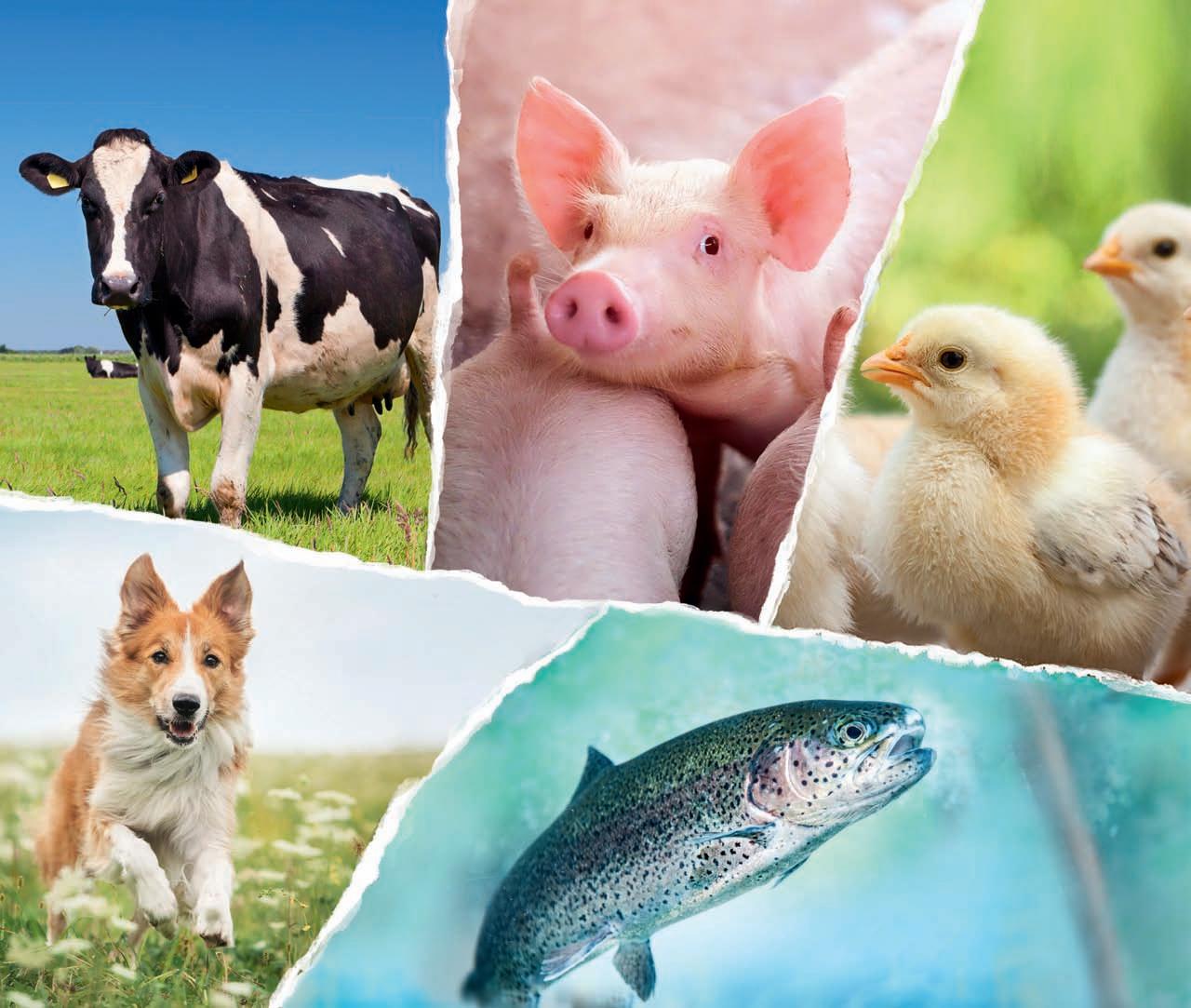
Follow us on:


Pet Food SuPPlement 2022 Page 1 Pets in Society 2 By Roger W Dean The Carbon Pawprint of Pets and What can we do About it? 6 By M.Sc. Kevin Truyts and M.Sc. Stuart W. Burdett Managing Moisture in Pet Food Production 10 By Victoria Thornber Trust – The Currency that Drives Business Growth in the 21st Century 13 By David Primrose Unlock the Power of Functional Hydrolyzed Yeast 18 By Francesca Susca, DVM, PhD Expert Insights; a 3-Pronged Approach to Preventing Mould and Stabilizing Kibble 20 By Sarah-Jane Godfrey Beta-1,3/1,6-Glucans Promote Well-Being of Obese Dogs 22 By Pauline Rovers-Paap Closing the Loop: How biomega® is Helping the Pet Food Industry Work Towards Zero Waste 26 Seaweed as a Premium Natural Prebiotic for Dogs 29 By Dr Jason Sands The Power of Postbiotics Giving Pets the Best Health Support 32 With Alana Harvey-White The Importance of Nutrition for Senior Dog Health By Chloe Poolman 34 Postbiotic Technology Invigorates Pet Nutrition Solutions for Microbiome and General Health 36 By James Kyffin, BVSc MRCVS Global Survey Shows Consumers Want Recognisable and Health-Promoting Ingredients in Pet Food 38 Pet Subjects 39 Contents 2022 Vol. 24 Subscription rates: Pet Food Supplement is distributed free of charge, to individuals based in Europe and involved in the pet food sector who have registered to receive a copy. To register to receive future issues, please visit www.pentlandspublishing.com/pfs. htm#register ISSN 0950-771X Views expressed by contributors are not necessarily those of the Publisher. © Feed Compounder 2022 Editorial assistant: Andrew Mounsey Advertisement/Sales Manager: Fiona Mounsey Editor: Ryan Mounsey Published by: Pentlands Publishing Ltd Plas Y Coed Velfrey Road Whitland SA34 0RA United Kingdom Tel: +44 (0) 1994 240002 Web site: www.petfoodsupplement.co.uk E-mail: mail@feedcompounder.com
Pets in Society
By Roger W Dean
Pet Populations - and the Pandemic
At first glance, it was a matter somewhat surprising that the Petfood Manufacturers Association (PFMA) reportedly found it so easy to compile data for pet populations in the UK for 2021, owing to the disruption of daily life caused by measures to control the pandemic. In retrospect, however, the PFMA’s researchers will have had some aspects of hive research made easier by the measures taken to control the pandemic. Given the advice to, where ever possible, work from home, the researcher’s knock at the door will produce a welcome response. Lockdown will have been a trial for many people confined by government fiat to their dwelling places and the researcher’s visit may even have been positively welcomed.
The effects of the pandemic on pet populations in the UK appear to have been dramatic, though there may be side effects which have yet to make themselves apparent. More on that later. The Pet Food Manufacturers’ Association recent release of its annual pet population data for 2021, confirmed that 3.2 million households in the UK have acquired a pet since the start of the pandemic. This has largely been driven by the so-called ‘Gen Z’ – born between 1997 and 2012, and Millennials, born between 1981 and 1996, two thirds of new owners are aged 16 and 34 and 56 per cent of new pet owners have children at home. Although 74 per cent of respondents claim their pet has helped their mental health through the pandemic, ‘the study raises pet welfare concerns’.
According to the PFMA, ‘There are now 34 million pets in the UK, including 12 million cats and 12 million dogs, 3.2 million small mammals such as guinea pigs and hamsters, 3 million birds and 1.5 million reptiles. In total, this equates to 17 million households that are responsible for their pet’s welfare. Notably, over a third - 38 per cent - of new owners claim that having a new pet was like having a new baby and almost a fifth of families with children admitted that training ‘was more challenging than expected’. Sadly, 5 per cent have already had to give up a pet and this figure increased to 11 per cent among families.
Nicole Paley, PFMA’s deputy Chief Executive commented that PFMA’s research confirmed the belief that ‘many more people are benefitting from pet ownership’ and that PFMA ‘are reassured by the mental health findings’. However, it was clear that PFMA needed ‘to consider the welfare of these new pets. As the survey highlighted, introducing a pet to a household in Covid times could have repercussions or create some unexpected difficulties.
Paley also noted that PFMA had looked in more detail at the future concerns of new pet owners. Perhaps worryingly, although just 15 per cent had ‘a pet-friendly office environment, only 10 per cent were concerned about returning to work and spending less time with their pet. This figure increased among younger generations, with 15 per cent of 16-34 year olds ‘concerned about spending less time with their pet
in the future’. Paley called for the PFMA to ‘work together with the pet care sector to ensure the 3.2 million households with new pets get the support they need’. Paley said that the support required was represented in terms of access to educational material, training and adequate flexible working from home ‘or pets in the office policies’.
RSPCA pet welfare expert Dr Samantha Gaines said that as these figures demonstrate, ‘a huge number of people have added a new pet to their family during lockdown’ while other pet owners had made the most of spending more time at home during the pandemic ‘to enjoy the company of their pets. Dr Gaines said that many of our pets ‘were now used to having us around all the time while others have never known any different so we have real concerns that life post-lockdown, both in terms of a new routine and spending time alone, could be really difficult for them to adjust’ which, as Dr Gaines observed, ‘is why it’s so important that owners start to prepare them now’. In the absence of this preparation, pets could be facing their own crisis.’
There is, as might be expected, a great deal in the literature regarding pets in the context of the pandemic. A disturbing article in the Guardian newspaper published on 1 December 2021 reported that ‘The cats and dogs that helped us through the pandemic are increasingly being dumped in the street or handed over to charities – and pet shelters are dealing with the fallout.
Pet Obesity
There is little doubt that ongoing economic development has brought significant advantages to much of the UK’s population, even if it sometimes associated with concerning physical aspects such as an overindulgence in food or alcohol. However, with the increased financial resources being enjoyed by many families, part of those additional resources may likely be spent on acquiring a pet.
As discussed above, with the intervention of the pandemic, the pet population of the UK has undergone an additional and, reportedly, substantial upwards further revision in pet numbers. In this context, veterinarians ‘have seen a worrying rise in obese pets’. The problem is not of recent standing. Another newspaper article highlighted the fact that pet obesity was ‘a growing problem’ in the UK – and the publication went on to highlight the fact that the article was ‘more than seven years old’. The article, quoting comments by the Peoples Dispensary for Sick Animals (PDSA) expressed concerns over the fact that ‘Increasing numbers of obese cats, dogs and rabbits are developing similar health problems to overweight humans’, adding that ‘lockdown had made things worse’.
The PDSA have engaged in a running commentary on the increasing problem of obesity in the nation’s pets. In a post on the PDSA’s website in 2019, it was reported that vets estimated that nearly half of dogs in
Page 2 Pet Food SuPPlement 2022
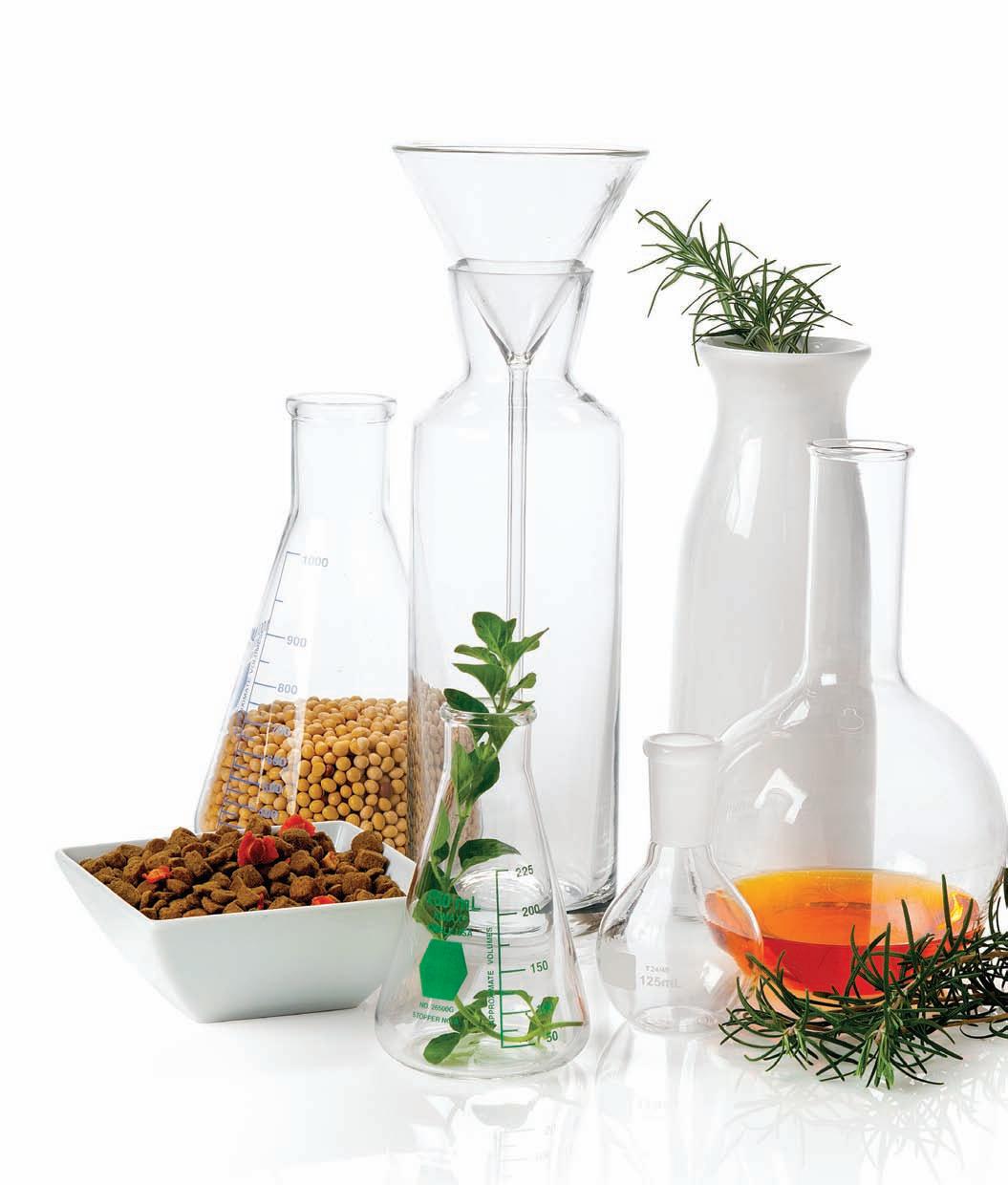

KEMIN IS ASSURANCE © Kemin Industries, Inc. and its group of companies 2022. All rights reserved. Trademarks of Kemin Industries, Inc., U.S.A. A NATURAL FIT, EVERY STEP OF THE WAY OXIDATION CONTROL PALATABILITY FOOD SAFETY NUTRITIONAL SUPPORT Come to discover our range of natural ingredients at booth No. 12.0-310 | Hall 12.0 24-27 May 2022 | Nuremberg, Germany Learn more at kemin.com/assurance_eu
the UK are overweight, pointing out that being obese puts dogs ‘at risk of health problems, and is likely to reduce how long they live’. PDSA stressed that it was ‘important to know what your dog’s ideal shape is and recognise when it changes’, stressing the fact that it was possible to control dogs’ weight with diet and exercise and urging dog owners to ‘Contact your vet if you are struggling to keep your dog at an ideal weight, they will always be happy to help’.
Dog Breeds and Behaviour
An interesting article in a recent edition of the Guardian newspaper cast doubt on the widespread view that the major determinant of dogs’ behavior is their breed.
This is an important element in anyone’s decision to acquire a dog. For example, Labradors are regarded as sociable and thus a good choice for a family with young children. Alternatively, Pit Bull terriers are popularly regarded as aggressive. This reflects development that have occurred since modern dog breeds began to emerge in the Victorian era, when the science of breeding began to be better understood and dogs began to be bred for specific purposes. They were also bred for physical characteristics - size, for example, ranging from the Great Dane to the tiny chihuahua.
From sociable Labradors to supposedly aggressive Pit Bulls, when it comes to canine behaviour there are no end of dog stereotypes. But research suggests such traits may have less to do with breed than previously thought. Recent research at the University of Massachusetts Medical School suggests that research revealed ‘a huge diversity of behaviour within each breed.’ One of the co-authors of the research findings said that anybody acquiring a dog would ‘have a really good chance of getting a dog that doesn’t match what people say that breed is supposed to be. Writing in the journal Science, the US researchers report how they analyzed survey responses relating to the physical traits and behaviour of 18,385 pet dogs, almost half of which were purebred, with genetic data analyzed for 2,155 of them.
Analysis of the survey results for purebred dogs suggested that about 9 per cent of behavioural variation was explained by breed. The researchers said that, for the most part, they had not seen strong differences between breeds but there were some aspects of the dogs’ behaviour that were connected to breed more than others. While no behaviour was exclusive to one breed, howling was more common among beagles, while Pit Bulls and retrievers were more ‘human sociable’, translated as comfortable with strangers.
There were also some differences based on dogs’ ‘ancestral functions’. For example, herding breeds were, among other traits, ‘more biddable’. But it remained that there was a high degree of variability between individual dogs, meaning it is difficult to predict a dog’s behaviour based on its breed.
To explore whether genetics explained the associations, the team analysed the behaviour of mutts that had different levels of ancestry from particular breeds. The results reveal some traits have a stronger genetic component than others. Labrador retriever ancestry was associated with mutts who had few qualms about getting wet, yet such ancestry appeared to have no link to human sociability. The researchers said that they would expect that, if Labrador retrievers were genetically more human social,
they should see that young dogs, with more Labrador retriever ancestry to be more human social.
While the research team’s other analyses found that human sociability was ‘highly heritable, they noted the young dog results suggest that the genetic variants involved do not appear to be more common in particular breeds. Instead, differences between breeds for this trait may be down to environmental influences or, even, owners’ perceptions. But not all behaviours were found to be heritable, including how easily a dog is provoked by a ‘frightening trigger’ – a finding that suggests that how aggressive a dog is may have little to do with genetics.
The team says that the study ‘has implications for owners’.
Cats Behaviour
The RSPCA has recently published a useful checklist for those keeping cats which provides a guide to any departure from the cat’s normal behaviour pattern.
Cat keepers are urged to be ‘vigilant’ to any changes in t cat’s behaviour. Changes could be a sign of distress, boredom, illness or injury, stress or fear. Changes in the cat’s behaviour could include high levels of grooming, hiding, sleeping hunched or altered feeding/toileting habits; all indicative of stress or fear. In addition, look for unwanted habits such as aggression, spraying indoors, disappearing or avoiding people; all signs that suggest your cat is in pain or frightened. The RSPCA urges cat keepers, if any of these symptoms become ‘an ongoing problem’ to speak to a vet or another qualified person.
The RSPCA says that cats ‘can scare easily’, so cat keepers are urged to make sure they can reach everything they need -. bed, water, litter or outdoors - without passing things or other animals that may frighten them. The RSPCA also warns that if your cat is scared with no place to escape and hide, ‘it may become aggressive’. Provide constant access to safe hiding places where they can escape if they feel afraid. It was observed that cats sleep for many hours of the day but, when they’re awake they need opportunities to exercise. If they don’t go outside, provide suitable indoor activities to keep them active.
Cats naturally use objects to scratch, mark territory, strengthen muscles and sharpen their claws. To allow this natural behaviour, provide sturdy scratching posts which are tall enough for your cat to use fully stretched. This is particularly important for indoor cats.
The RSPCA proclaims that ‘Kindness is key!’ Never shout at or punish your cat, they are very unlikely to understand and can become more nervous or scared.
Whereas the penultimate paragraph refers in particular to cats that live largely indoors and, as in a highly built-up area, will have little opportunity to spend time out of doors, cats that live in a rural environment need a different regime. A cat’s natural instinct is to hunt its prey but there is a real concern domestic cats are impacting the welfare of local wildlife. To help prevent your cat bringing home unwanted surprises, and to protect local wildlife, the RSPCA recommend that cat keeper restrict outdoor access at dusk and dawn when wildlife is most active, at least an hour before sunset and an hour after sunrise. Access should also be restricted after bad weather such as rain, to allow birds to come out and feed. Finally, the RSPCA recommends attaching a bell to a quick-release safety collar.
Page 4 Pet Food SuPPlement 2022
SPECIFIC FOR YOUR SUCCESS












SELECTED











NATURAL MICROBIALS FOR PETS’ WELL-BEING




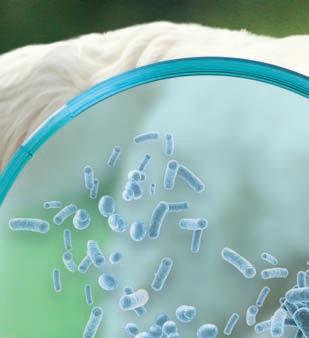




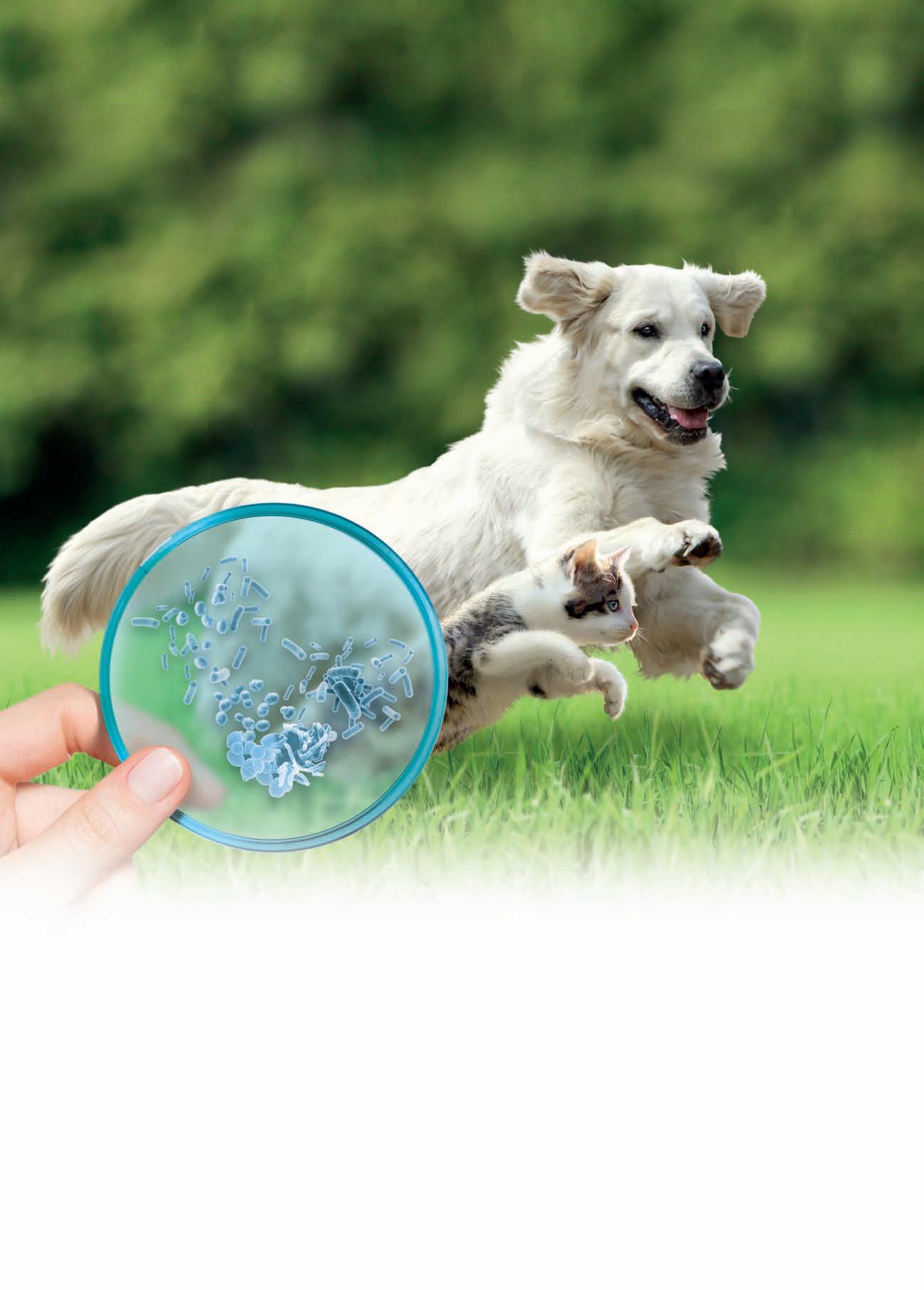
As a partner, Lallemand Animal Nutrition develops, produces and markets a complete range of high-value yeast and bacteria products –including probiotic and yeast derivatives– specifically selected to help you improve companion animal well-being in a natural way.




DIGESTIBILITY ENHANCEMENT IMMUNITY SUPPORT OXIDATIVE STRESS CONTROLRCS Lallemand 405 720 194LANPET_ADV_ENG_092017. LALLEMAND ANIMAL NUTRITION SPECIFIC FOR YOUR SUCCESS www.lallemandanimalnutrition.com
The carbon pawprint of pets and what can we do about it?
By M.Sc. Kevin Truyts and M.Sc. Stuart W. Burdett, DSM Nutritional Products
Sustainability in pet food has gained increasing attention in recent years, particularly as sustainable feed alternatives earn more share of the market. Climate change is happening fast, and in order to combat it we should reduce our emissions of greenhouse gases (GHG) drastically. Broad governmental regulations, innovation and technology, carbon tax programs and other incentives will help steer us towards these highly needed reductions as we work to keep global warming within the +1.5°C as agreed in the Paris Climate Agreement. We as humans can have our own impact by making more sustainable consumer choices. But we should also do that for our beloved pets. In 2020 there were 471 million dogs and 370 million cats worldwide and numbers are continuing to grow year after year. During the Covid-19 pandemic, pet ownership grew even faster as people felt more isolated and as a result, sought out companionship. In 2020, in the US for example, pet ownership increased by 4%, a doubling versus 2019 (1).
What is the carbon pawprint of pets and pet food?
The biggest contributor to this “pawprint” is pet food. A US report from 2017 revealed that all food consumed by the US dog and cat population represents a release of 64 Mtons CO2eq per year. If you look at dietary energy consumption of US dogs and cats it represents 62 million Americans which is approximately 20% of the US population (2). In a new study by the School of Geosciences (University of Edinburgh) from 2020, global dry pet food production – so wet pet food production not taken into account – is associated with 56-151 Mtons CO2 eq per year (1.1 - 2.9% of global agricultural emissions), 41-58 Mha agricultural land use (0.8-1.2% of global agricultural land use) and 5-11km³ freshwater use (0.2-0.4% of water extraction of agriculture). Twice the land area of the UK would be needed to produce the yearly global volume of dry dog and cat food (3). But as global wet pet food production was not taken into account, this is an underestimation. Furthermore, with increasing demand for human-grade meats, pet food is estimated to be responsible for a quarter of the environmental impacts of meat production in terms of water, fossil, phosphates and pesticides.
How can we reduce the footprint of pet food?
There are many obvious ways in which pet food companies can and are continuing to reduce their environmental impact. Industry wide efforts have focused on all aspects of pet food spanning from, recyclable
product packaging to the reduction of overfeeding, food waste and the use of alternative, sustainable protein sources. In the case of pets, tackling the impact of food is the most substantial and easily attainable way to reduce emissions. Utilization of alternative protein sources has been growing in the pet industry, producing nutritionally identical proteins without the environmental, animal and safety downsides
Unfortunately, current pet food trends encourage owners to feed their pets much of the same food that humans eat, high-quality “human grade” meat, organic produce and to reduce their reliance on ingredients such as grains and animal by-products (ABPs). While this approach is emotionally appealing, it is not necessary for pet’s health, nor is it environmentally sustainable. In fact, ABPs and the process of rendering diverts billions of pounds of food waste from landfills; reclaims water by not using it to wash animal leftovers into waste streams; and by using these animal parts (in nature, the preferred and most nutritious parts for wild cats and canines) to make protein ingredients for pet food, less protein needs to be grown and processed (4). Therefore, it remains imperative that along with the increased awareness around the use of sustainable products and practices, manufacturers continue to do their part to educate consumers on sustainability and animal nutrition.
How does DSM contribute to further improve the sustainability of pet food?
DSM has been pioneering solutions to tackle these challenges and reduce emissions from animals for many years, especially with respect to animal proteins. DSM has committed to its own internal company targets, including Science-Based Targets Initiative commitments to cut both our absolute emissions and our product carbon intensities. As part of that work, we launched the “We Make It Possible” strategic initiative last year- which further increases our focus on how we can positively contribute to sustainable animal production by developing and applying innovative feed additives that help to reduce the environmental impact of animal protein production.
One of the biggest challenges when it comes to improving pet food sustainability is the lack of specific, reliable measurement. Many of the criticisms of pet food are based on estimates and global averages like the ones listed above. It is very difficult to track improvements (or the lack thereof) if we don’t measure their impact or don’t even know what baseline we are starting from. To that end, DSM has developed,
Page 6 Pet Food SuPPlement 2022
*Data from DSM Environment Product Declarations, 2021
** Value of CO2 saving assuming a Carbon Credit or tax of €50 per tonne of CO2 together with Blonk Consultants, (a leading Life Cycle Analysis/LCA company) a new service called Sustell™ to calculate up to 19 different sustainability impacts related to animal protein production and advise on potential improvement opportunities. Sustell™ provides farm-level foot printing analysis for all major animal protein sources, enabling new and better data for all purchasers of animal proteins. DSM and Blonk continue to update the databases as part of the Global Feed LCA Institute and add new modules to Sustell™ that will be of use to the pet food industry. For example, DSM have calculated that on average, of the 819 kg of CO2 generated per ton of dog food produced, around 50% is from animal protein whilst 50% is from vegetables. For cats, where 790 kilograms of CO2 is generated per ton of feed, this rises to 70% from animal proteins, with only 30 % from vegetables. As part of that work, we have developed Environmental Product Declarations (EPDs) with footprint data for our major products to share with our customers, so they can confidently include climate change data and other 15 environmental footprints for our products in their feed and pet food. By ensuring pets are able to process their food efficiently, extracting the maximum nutritional value from it, we can reduce
the amount they need to eat, whilst also allowing for the use of different raw materials with lower environmental footprints. Through our expertise in micronutrition, DSM can tailor feeds to the unique age, species, and health requirements of the animal, making sure they receive the optimal quantities of vitamins and minerals. An increase in feed efficiency of just 5% reduces both the footprint of keeping an animal and the healthcare costs, passing on the benefit to owners.
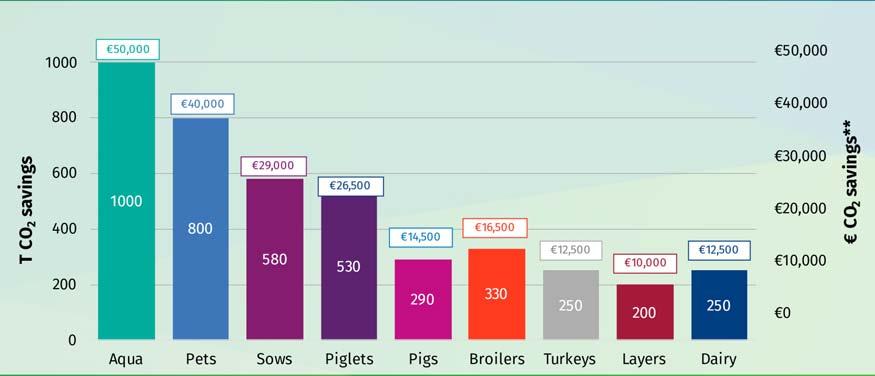
As so much pet food is made from animal proteins, reducing the emissions profile of animal agriculture would have a knock-on effect on the footprint of pet food, as would reducing the amount of land needed to feed each animal. DSM has been leading on the creation of solutions which directly and indirectly reduce the emissions profile of animal agriculture, therefore directly increasing pet food sustainability. This transition to a lower carbon future for animal proteins can be facilitated by supplying nutritional ingredients such as vitamins with industry leading performance, improving the efficiency of animal production systems while reducing the carbon footprint of these feed additives and those within which they are utilised.
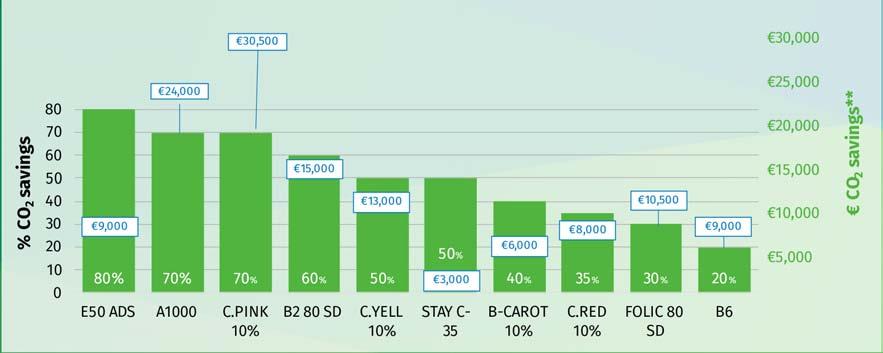
Pet Food SuPPlement 2022 Page 7
Figure 1: CO2 savings and potential € value (carbon tax) per 10T feed additive* (DSM vs main alternative, 2021)
Figure 2: CO2 savings and potential € value (carbon tax) of a more sustainable vitamin source for a 100k T feed producer*
*Examples of CO2 savings based on average vitamin levels used in 100k T feed (DSM Premix Carbon Calculator) **Value of CO2 saving assuming a Carbon Credit or Tax of €50 per tonne CO2
The innovative nutritional solutions targeting these emissions include Balancius, Vevovitall and a number of feed enzymes and additives. By increasing gut efficiency in poultry, Balancius has the potential to reduce CO2 emissions by an estimated 9 million tonnes annually, on the basis of estimates produced by the UN Food and Agriculture Organization – the equivalent of taking 3.7 million cars off the road. Vevovitall on the other hand, through modulations of the microbiota in the gut and lowering the urinary pH, can reduce the ammonia emissions on the farm by 22%. ProAct improves the digestibility of proteins, thereby reducing nitrogen emissions to the environment by up to 17%. It also enables the use of more diverse raw feed materials, reducing the reliance on soy and thereby helping to cut deforestation for soy cultivation. If ProAct were to be used globally in broiler diets, deforestation could be reduced by 3.1 million hectares a year.
When using by-products from beef or dairy, the large percentage of GHG emissions, especially from methane produced by the rumen fermentation, contributed by cows and steers has a significant impact on the industry’s overall footprint—a single cow can produce 3 tonnes of methane per year. With this in mind, DSM’s scientists produced Bovaer, a novel feed additive that suppresses the enzyme triggering methane production in the cow’s rumen – that has the ability to reduce methane emission from cattle by 30-90% and is also effective in other ruminants such as sheep, another main pet food ingredient.
In 2018, DSM and Evonik joined forces in the joint-venture called Veramaris, which makes a highly sustainable, novel EPA and DHA omega-3 source from algae for the pet food industry made from marine microalgae oil, without needing to use fish oil. This protects animal health, whilst also reducing strain on our struggling fish stocks, making supplies of human food more secure. As a result, 1 kg of Veramaris® Algal Oil replaces 60 kg of wild catch fish!
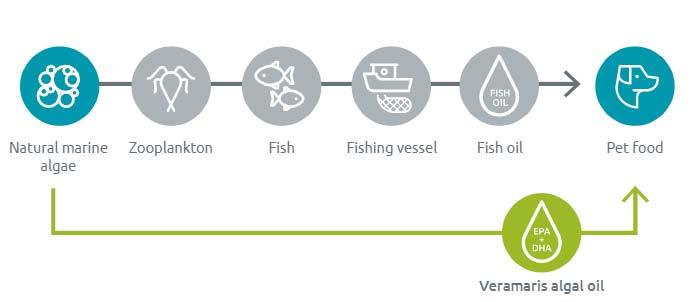
In 2022 DSM further reorganized their business groups and positioned the DSM Pet business under the Food & Beverage business
group, focusing on Taste, Texture and Health. Expanding the portfolio of products and innovation to help boost process efficiencies, reduce food loss and waste and lower the environmental impact of production and consumption – while also enhancing food’s nutritional profile. As a part of this ongoing development in specialty proteins that are produced within planetary boundaries, DSM’s recent acquisition of Vestkorn Milling, a supplier of pea- and bean-derived proteins, starches and dietary fibres, will complement and further accelerate this growth. These efforts are part of DSM’s commitment to reach 150 million people with plant-based protein foods by 2030, in alignment with our recently announced series of quantifiable food system commitments.
Conclusion
It is evident that only in close collaboration across the whole pet food value chain, can the pet food industry start to measure and significantly reduce its environmental footprints and become an increasingly environmentally friendly industry. DSM hopes to encourage manufacturers and suppliers of pet food to think about our common goals on sustainability (ref. UN Sustainable Development Goals) and to consider what we can do to make these goals a reality. It won’t be easy, but by working together and applying our technologies, products and services at hand we can make it possible!
References
Euromonitor International: Pet care: Quaterly Statement Q4
2020
Okin GS. ‘Environmental impacts of food consumption by dogs
and cats’. PLoS ONE 12(8), 2017
Alexander P. ‘The global environmental paw print of pet food’.
Global Environmental Change 65 (2020) 102153
Donna Berry. ‘It’s a necessity:’ finding more sustainable 4. ingredient sources for pet food and treats. April 27, 2021.
Page 8 Pet Food SuPPlement 2022
1.
2.
3.
Figure 3: Veramaris® Algal Oil is a novel EPA and DHA omega-3 source from algae for the pet food industry made from marine microalgae oil which reduced the strain on struggling fish stocks.

INTERZOO.COM TOGETHER AGAIN AT THE WORLD’S LEADING TRADE FAIR IN NUREMBERG With this unique overview of the market, you will benefit from countless ideas for structuring your product range, the most important trends, and innovations. And from valuable business contacts – all with a very personal touch at Interzoo. Follow us! Organization Honorary sponsor Organizer Admission granted to authorised trade visitors only. Join us – personally and successful 37. International Trade Fair for Pet Supplies 24 – 27 May 2022 | Nuremberg, Germany
Managing moisture in pet food production
By Victoria Thornber, Companion Animal Manager, Devenish
Moisture plays a key role in the quality of pet food. It needs to be carefully managed to ensure food safety and maximise production efficiencies. SmartMoisture, a new patented solution from Devenish can help support both.
Moisture levels in pet food production can reach as high as 25%30% from the addition of water and steam in the mixer, conditioner and extruder before being reduced in the drier and cooler. Pet food is typically dried to a moisture content that is low enough to reach a water activity that is shelf stable. Typically, the moisture content is less than 10 percent, but this target varies between manufacturers and recipe formulations and is based upon achieving a water activity (aW) level that will not support pathogen growth.
It is key to reduce free water, the pre-curser to mould growth.
The rate at which moulds and bacteria grow during feed processing and storage depends on factors such as pH, temperature, oxygen availability, and most importantly, water activity of the food.
Moulds negatively impact product shelf life, reduce pet food palatability, and the spores may cause an immune response. Some moulds, such as Aspergillus, Fusarium and Penicillium , produce secondary fungal metabolites called mycotoxins. In pets, these mycotoxins can have a negative impact on pet health.
What is water activity and what impact can it have on feed?
Moisture content merely describes how much water is in the product. Water activity describes how much of that water is free and therefore available to microorganisms for growth. Hot temperatures cause water to migrate during storage, while humid conditions will result in condensation, both resulting in higher activities of free water. The growth of microorganisms will be hindered when the water activity of a pet food reaches below 0.9 for most bacterial pathogens and below 0.67 for most moulds. By managing the water activity of pet food during processing and storage, we can reduce the proliferation of microorganisms and ensure food safety.
Heat-treatment steps can kill bacterial pathogens such as Salmonella, but moulds are stable and won’t be destroyed. This has necessitated the need for alternative solutions.
Managing moisture in pet food production
Grains are generally hydrophobic, and water does not simply just get absorbed by them. Pet food manufacturers will dry and cool dog food to lower moisture content in order to ensure low water activity levels insuring a prolonged shelf life.
Lower moisture pet food comes at a cost as every 1% unnecessary moisture reduction equals 10kg pet food per ton lost. In addition, companies are spending more time and energy drying kibble down.

SmartMoisture allows pet food producers to safely produce and send out pet food with optimal moisture content but lower water activity. That means with SmartMoisture, moisture levels can be managed to ensure minimum drying and maximum yields while maintaining shelf-life stability.
Stabilising propionic acid

SmartMoisture consists of a combination of propionic acid esterified to glycerol, buffered formic acid, and surfactants. It is 30% more concentrated than any other product on the market due to the stability of the glycerol esters. The propionic acid esterified to glycerol is a patented process used to buffer and stabilise propionic acid (Figure 1). It increases retention time of propionic acid in feed ensuring

Page 10 Pet Food SuPPlement 2022
Figure 1: Stability of propionic acid from SmartMoisture

+44 (0)2890 755566 smartmoisture.com ↘ A patented moisture management technology Key benefits Consistent moisture control Improved protection against mould and microbial growth Better starch gelatinisation Higher throughput and reduced energy consumption
longer lasting microbial inhibition. Glycerol acts as a humectant and emulsifier and can hold up to 1,000 times its own weight. The surfactant reduces the water’s surface tension, therefore improving moisture distribution. Glycerol and the surfactant improve water absorption into feed particles and help to stabilise water activity.
European pet food trial
A trial was carried out in 2021 by a pet food producer who exports pet food globally. Due to transport challenges associated with shipping products to tropical regions, the company reduces feed moisture to below 7% to reduce the risk of microbial growth. The trial assessed two treatments:
Control: No SmartMoisture with moisture level reduced to 7%
Treatment: Maximum of 750g/ton SmartMoisture inclusion with
moisture level reduced to 9%
SmartMoisture was added in the mixer with all the usual liquid additions. Samples were taken after production and at bagging. Moisture percentage and water activity was measured.
Results
SmartMoisture consistently kept aW below 0.5 even at higher moisture levels, thus allowing the dog food to be dried off to a higher moisture content. Bulk production increased without compromising quality. Throughput was also improved with kibble spending less time in the dryer and cooler.
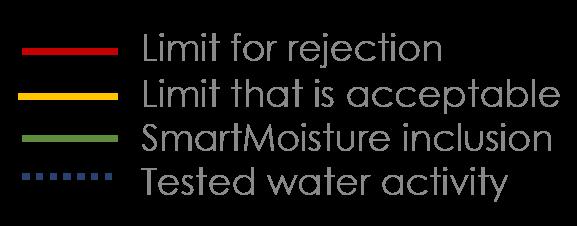
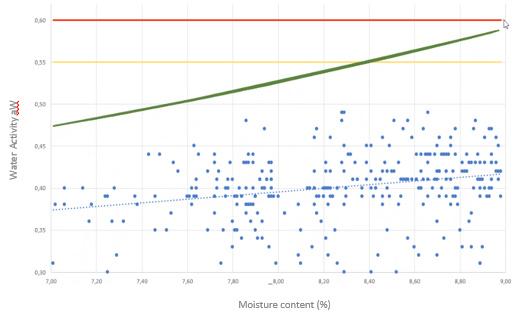
The humectant properties of SmartMoisture stabilised the water activity when the dog food was dried to a higher moisture content. The propionic and formic acid, as part of the glycerol esters, were absorbed into the feed particles ensuring a stable product that is protected against microbial growth.
This gave this customer confidence to ship feed at higher moisture content, thereby increasing yield and profitability.
A second trial, carried out in at a dog food manufacturer delivered similar results. Additional moisture was included at 2% with a water/ SmartMoisture solution. Final moisture saw an increase of up to 3% in the dog food with water activity remaining within the targeted KPI levels. This showed the effect that SmartMoisture had on steam absorption. SmartMoisture gave improvements in production efficiency with extruder throughput improving by up to 18.0%.
Multiple benefits for your business
SmartMoisture’s novel technology allows pet food manufacturers to:
•
Manage moisture levels
•
Keep water activity low and stable
•
Protect feed against microbial and mould contamination
•
Improve starch gelatinisation
•
Save energy by reducing drying and cooling
•
Increase throughput
For more information visit www.smartmoisture.com or contact your local Devenish representative.

Page 12 Pet Food SuPPlement 2022
•
•
Figure 2: Water activity of SmartMoisture included in pet food
Trust – The currency that drives business growth in the 21st Century
By David Primrose, Petfood Consultant, Synergy Petfood

Trust – What is it and why does it matter?
Trust is intangible and we can’t touch it. However, it plays a highly significant role in shaping our daily lives, with both positive and negative outcomes, as outlined in the following examples: -
more pet owners became interested in making “homemade” petfood.
Trust or mistrust affects all aspects of business performance both internally and externally: -
Internal effects – engaged workforce, with greater employee
Positive - building personal and business relationships; buying

• petfood that pet owners believe will actively support their pet’s health.
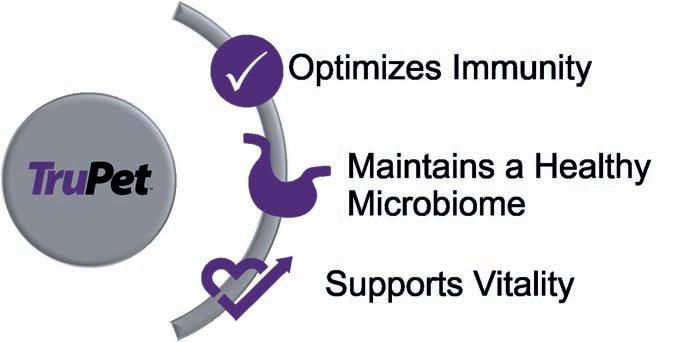
• (DCM) on sales of “grain free” petfood.
Negative - regional conflicts; the effect of Dilated Cardiomyopathy
Like all commercial enterprises, trust matters as it drives the success of the global petfood industry. History records that trust in commercial petfood was damaged by the melamine crisis of 2007 – 2008. This resulted in the largest and most costly recall in petfood industry history and the deaths of 000’s of pets. Anecdotal evidence also indicates that
• retention and increased productivity.
• relationship with regulatory authorities.
External effects – customer brand loyalty; supplier relationships;
Collectively these trust / mistrust effects reach across all stakeholders involved in the petfood supply chain, including willingness of pet owners to purchase a petfood brand.
Trust is also important when it comes to innovation and market implementation of new products and impacts success, this is an important factor when we consider the need to implement sustainable raw materials and new food processing technologies in the petfood industry.
Unleash
www.diamondv.com/TruPet TM Alana Harvey-White Alana_white@cargill.com 07818 004351 Marion Turnbull Marion_turnbull@cargill.com 07818 004363 For more information contact: Postbiotic
the Power of Postbiotics
Humanisation of petfood and future evolution
Commercial petfood dates to the 1860’s with Spratt’s dog biscuits, with wet petfood entering the market in the 1920’s and dry kibble petfood appearing in the 1950’s. This indicates that petfood innovation is not new and continues to drive market growth now and in future.

For many years, the concept of humanisation has driven both market growth and innovation in the petfood industry and this trend is expected to continue in future. The term “humanisation” of petfood does not have a formalised, harmonised definition and means different things to different people. For examples, it includes concepts like:Pet owner perception of pets as “members of the family”
•
•
Formulation of ingredients that promote health and wellness

In general terms, a (human) food system can be considered as a complex interlinked web containing: stakeholders e.g., consumers, food producers, retailers and regulatory authorities; processes e.g., food manufacturing, distribution, retail; and external influences e.g., climate, diseases, environment, and consumer beliefs that affect the production and consumption of food. This concept also applies to petfood, but why is it important?
Clearly trust in safe, legal, and nutritious petfood of the quality expected is key to both pet owners and petfood manufacturers. However, trust is more likely to become of increasing importance as the industry faces up to challenges in the 21st Century.
Expectation of human food industry standards e.g., “human”
• grade ingredients; human food industry manufacturing, quality, and safety standards

• poultry, vegan / vegetarian and flexitarian food.
Adoption of human beliefs e.g., organic ingredients, “free range”
Why trust in petfood matters more than ever.
Trust in food and petfood is essential to ensure it is safe, nutritious, legal and of the quality expected. When any of these fails, trust is damaged and we, our pets and the petfood industry businesses suffer undesirable effects like illness or we lose business. Ensuring safety, nutritional adequacy, legality, and quality requires a petfood system.
Speciality Ingredients for Pet Foods
Petfood in the 21st century faces new opportunities and challenges.
Based on ongoing humanisation, sustainability is a key trend that is likely to translate into the petfood industry on a growing basis, as pet owners become increasingly aware of issues like climate change and raw material availability. As a concept, sustainability embraces many aspects around a common theme of efficient resource utilisation including land use, greenhouse gas emissions, energy, water, packaging, and ingredients.
In addition to consumers (pet owners) pushing development of sustainability, it is likely that other stakeholders including the petfood manufacturing sector (pet food manufacturers and suppliers), and regulatory authorities will also drive the sustainability agenda. To achieve sustainability goals, it is likely that the petfood industry will implement the use of alternative sustainable ingredients e.g., insect protein, microalgae-based oils, and the possibility of new food processing technologies. In implementing these novel technologies this will align the petfood industry with the human food sector’s sustainability initiatives and further enhance the concept of petfood humanisation.
Whilst the fact that pet owners will be one of the driving forces for sustainability will help ensure engagement with novel technologies (ingredients and food processing), the industry must ensure effective messaging to build trust in these.
Consumer acceptance of alternative food ingredients and novel food processing technologies.
Like all industries, the on-going success of the global petfood industry depends on innovation in other parts of the consumer goods sector, lack of innovation is seen as contributory factors in business failure of companies like Blockbuster and Toys R Us1. We see many examples where innovation in human food systems translate into petfood including the use of ingredients to promote gut health in both humans and pets e.g., probiotics and pre-biotics and technologies like High-Pressure Processing (HPP) used to extend shelf-life and control foodborne pathogens in human foods like guacamole and “raw”
Page 14 Pet Food SuPPlement 2022
petfood.
Inovitec Ltd Unit 5A, Tarporley Business Centre, Nantwich Road, Tarporley, Cheshire, CW6 9UT. E: info@inovitec.co.uk T:+44 (0)1829 730407
Adifo - BESTMIX® develops and services sector-specific software tools for the international nutrition industry. We enable you to gain maximum control over your core processes and guarantee the protection of critical business knowledge.
Adifo - BESTMIX® develops and services sector-specific software tools for the international nutrition industry. We enable you to gain maximum control over your core processes and guarantee the protection of critical business knowledge.
www.bestmix.com
Optimize your feed formulation


Get the most out of your quality data

BESTMIX® Software: Recipe Management and Quality Control
BESTMIX® Software: Recipe Management and Quality Control
Staying ahead of the competition requires smart feed formulations. You – as formulation manager – are key in this strategy. But how do you create the best quality and lowest cost recipes – under any conditions and at any time?
BESTMIX® provides the answer.
Staying ahead of the competition requires smart feed formulations. You – as formulation manager – are key in this strategy. But how do you create the best quality and lowest cost recipes – under any conditions and at any time?
BESTMIX® provides the answer.
This user-friendly software makes it easy to manage accurate nutritional values, production parameters and recipe specifications. You can adapt instantly to volatile material costs, ingredient stocks and purchasing positions. The results are perfect recipes that can be translated directly into practical products and synchronized automatically with labelling and safety data.
This user-friendly software makes it easy to manage accurate nutritional values, production parameters and recipe specifications. You can adapt instantly to volatile material costs, ingredient stocks and purchasing positions. The results are perfect recipes that can be translated directly into practical products and synchronized automatically with labelling and safety data.
Want the least cost recipe, no matter how challenging the requirements? Want to make the best decisions based on correct quality data?
Want the least cost recipe, no matter how challenging the requirements? Want to make the best decisions based on correct quality data?
Call us today on +32 50 30 32 11 and get our BESTMIX® solutions.
Call us today on +32 50 30 32 11 and get our BESTMIX® solutions.
The smartest way to beat the competition.
The smartest way to beat the competition.
9846_PNutrition_Pets Intl Ad_Half_208x131.pdf 1 09/03/2020 10:11
Often new foods can be seen as “Frankenfood” for example genetically modified food ingredients. Another example of food that faced challenges with consumer acceptance is sushi. Whilst widely accepted in Japan, when first introduced outside the region western consumers were at first reluctant to engage with the concept of eating “raw” fish. However, in the US alone the market value of sushi restaurants was estimated at US$ 22 billion in 20192 indicating how “alternative” foods have been accepted.
Acceptance of sushi has been identified by researchers in the US and Australia as a model in prediction of consumer acceptance of insects3
A critical success factor in successful implementation of innovative concepts is how we convey and present the benefits and opportunities to consumers who might distrust these, as outlined in the examples above.
The impact of (mis)information sources on trust
Like it or loathe it, we live in the digital era where social media is an important source of (mis)information that we are bombarded with 24 hours a day. This is an important determinant of how we believe in trust.
Depending on how we respond to this information means the difference from positive or negative outcomes and actions. We see this in all walks of daily life from military conflict, how we engage with new products and how we purchase the petfood used to feed our pets daily. An indication of the growing importance of on-line sources of information is indicated in research reported in the USA in April 20214, this showed that use of social media by US adults grew from 5% to 72% in the period 2005 – 2021.
The information we see on-line influences our decision-making process where we have trust or mistrust in an event or a product that affects how we respond, for instance petfood purchasing decisions.
For many years we have known that on-line information sources influence petfood purchasing decisions. For example, a 2021 report5 on “grain free” petfood purchasing decisions in North America and Europe, indicated that over 40% of dog owners used online resources to get their information about pet food with the actual number depending on different demographic information (country, age etc.). This research is also in line with other findings on the importance of online sources, as indicated in a report on the Italian petfood sector6
These reports also indicate the importance of other information sources including veterinarians, veterinary staff, and pet stores in influencing petfood purchasing decisions.
Whatever information source is used the important factor is that, depending on pet owner perception of the information, it either builds trust in the petfood or damages it.
Due to the interdependencies and complexity of any food system, including petfood, for effective successful change e.g., implementation of sustainable ingredients like insect protein, a “systems approach” is required. This helps us understand the factors and interdependencies that can affect trust in the food that our pets eat. For example, climate change might mean that some “conventional” petfood raw materials are no longer sustainable e.g., fish oil used for health and wellness in
petfood or meat from livestock farming. For nutritional adequacy and society demands on sustainability, we might then consider sustainable alternatives like algal oil or insect protein.
Whilst these might be feasible from a technological perspective, successful implementation requires us to adopt a systems approach which considers all stakeholders, processes and external influences outlined above.
One key success factor is consumer (pet owner) engagement. This is fundamental to building trust and enables us to overcome any concerns about the sustainable alternatives and explain the benefits. Consumers are not “homogeneous” in their beliefs and many factors play a key role in how we perceive “new” food / ingredients, for example microalgae, in the food we eat7
Due to the need to implement change in the human food system e.g., for sustainability, there is a lot of on-going research into trust in food systems, including how we engage and communicate with consumers. This is an area where the petfood industry might benefit in terms engagement with pet owners.
The question is how can we best use social media and other approaches to implement (food) messaging effectively to engage with pet owners and build trust in development and implementation of “next generation” petfood ingredients?
The answer here might also lie in humanization, with the petfood sector adapting and adopting the learnings from consumer engagement in “new” food systems and next generation ingredients. Time will tell!
References
1. Innovate Or Die: How A Lack Of Innovation Can Cause Business Failure viewed on-line on 16th March 2022 at https://www.forbes. com/sites/biancamillercole/2019/01/10/innovate-or-die-how-a-lack-ofinnovation-can-cause-business-failure/?sh=4ec902122fcb
2. Market size of the sushi restaurant sector in the United States from 2011 to 2019, with a forecast for 2020 and 2021 https://lb-aps-frontend.statista. com/statistics/1176560/sushi-restaurant-industry-market-size-us/
3. Disgust, sushi consumption, and other predictors of acceptance of insects as food by Americans and Indians; Matthew B. Ruby, Paul Rozin, Disgust, sushi consumption, and other predictors of acceptance of insects as food by Americans and Indians, Food Quality and Preference, Volume 74, 2019, Pages 155-162,
4. Social Media Fact Sheet, April 2021, viewed on-line at Demographics of Social Media Users and Adoption in the United States | Pew Research Center on 3rd March 2022
5. Article Source: Grains on the brain: A survey of dog owner purchasing habits related to grain-free dry dog foods; Banton S, Baynham A, Pezzali JG, von Massow M, Shoveller AK (2021) Grains on the brain: A survey of dog owner purchasing habits related to grain-free dry dog foods. PLOS ONE 16(5): e0250806. https://doi.org/10.1371/journal.pone.0250806
6. Vinassa, M., Vergnano, D., Valle, E. et al. Profiling Italian cat and dog owners’ perceptions of pet food quality traits. BMC Vet Res 16, 131 (2020).
7. Consumer views about the Next Generation proteins for food in Europe, Arvola et al (Nextgen protein Eu project)
Page 16 Pet Food SuPPlement 2022
FEEDTECH started to operate in the feed industry as a family business in 1969 and produced high-quality animal feed for many years. Focusing on machinery production in the 2000s, FEEDTECH has begun to offer bespoke solutions for the needs of the feed industry and establish turnkey factories. Pet food factories, fish feed factories, animal feed factories, premix factories, and biomass pelleting facilities are within the scope of FEEDTECH’s production.
Each project must be assessed on its requirements. FEEDTECH offers a full range of processing machines and equipment for the pet food industry – from raw material intake to finished feed bagging – as a single unit or complete plant solution. Whatever the desired size, shape, or moisture of the pet food might be, Feedtech machines enable the production of all feed while focusing on the customer, cost-efficiency, and high standards.
Feedtech has a reputation for being one of the largest feed mill machinery manufacturers in Turkey and Europe. It works to meet the needs of its customers in the best way possible and develops projects based on production efficiency. When necessary, it makes improvements by renewing completed projects.
Go Green Pelleting Solutions Ltd
Main UK Agent for Feedtech equipment
Go Green are suppliers of new and used feed mill and biomass pelleting equipment

Can design, supply and install complete projects or supply only
Feedtech supply a full range of equipment for the feed milling industry: presses, coolers , hammermills , conveyors etc etc
Also supply complete turn key milling solutions.
Unit 8A Brindley Road
St Helens
WA9 4HY
Mick Swift Mobile – 07500887637
David Kelly Mobile- 07500335621
Office Number – 01744808600

www.gogreenpelletingsolutions.co.uk

Unlock the power of functional hydrolyzed yeast
By Francesca Susca, DVM, PhD, Pet Development Manager, Lallemand Animal Nutrition
YELA PROSECURE is a specifically designed non-GMO Saccharomyces cerevisiae hydrolysed yeast. It offers highly digestible and functional nutrients that support animal well-being, digestive care and product palatability while contributing a balanced profile of free amino acids.
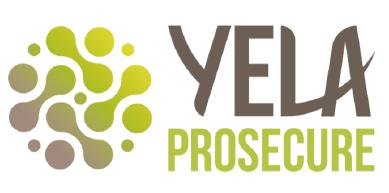
With more than 100 years of expertise in yeast production, Lallemand is a global leader in yeast development and applications in all areas of the food chain, including baking, speciality cultures for cured meats and wines, human health solutions and animal nutrition. Lallemand works continuously on the screening of different yeast biomass and on the optimization of the production process, which led to the development of YELA PROSECURE. The controlled hydrolysis process, conducted with the addition of specifically selected exogenous enzymes, ensures high nutrient digestibility and functionality while offering reliable results in terms of product quality and availability.
The importance of specific yeast hydrolysis technology
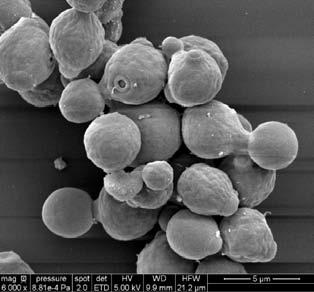
In the case of autolyzed yeasts, the yeast cell lysis is partial, involving yeast endogenous enzymes only, leading to less control in the final product composition. As an illustration: imagine eating a watermelon. If you do not process it in any way, it will be almost impossible for you to benefit from its nutrients. This situation can be compared to a non-lysed inactivated yeast. Autolysis can be compared with trying to open the watermelon without any tools. You could, for instance, smash it on the table and you would end up with different pieces of fruit; complicated and variable to eat, but still better than the intact watermelon.
will be. In the example of the watermelon, we would use a sharp chef’s knife to cut the melon into perfectly edible pieces, rather than a butter knife.
Providing functional nutrients with a triple action along the digestive tract
In the mouth: with 4.9% free glutamic acid, this functional yeast product acts as a palatability enhancer. Originally found in Kombu broth, glutamic acid offers the natural umami flavour we associate with traditional Chinese cooking; which monosodium glutamate (MSG) was created to mimic; and is a natural component in many fermented and aged foods such as soy sauce and Worcestershire sauce.
In the upper gut: highly digestible proteins, a high level of free digestible amino acids and small peptides, with early and fast amino acid absorption kinetics. This advantage is related to Lallemand’s mastering of the production process, showing the importance of a controlled hydrolysis which makes proteins more accessible, having been lysed into free functional amino acids and small peptides that are readily and directly absorbed.
In the lower gut: the remaining fractions consist of fermentable insoluble carbohydrates, leading to an improvement of microbial diversity and activity with a release of valuable short chain fatty acids such as butyrate.
Compared to whole-cell inactivated yeasts and autolyzed yeasts, hydrolysis is a much more controlled process as it involves the addition of specifically selected enzymes during the production process to optimize and orient the lysis, ensuring a specific level of functional ingredients and a consistent batch-to-batch product composition.
Finally, hydrolysis can be compared to using a good knife. Of course, the better your tools (i.e., enzymes), the better the hydrolysis
In comparison, whole-cell inactivated yeasts are not lysed, and therefore have lower nutrient digestibility and functionality.
Page 18 Pet Food SuPPlement 2022
Hydrolyzed yeast cells (scanning electron microscopy).
Functional benefits of amino acids and small peptides
YELA PROSECURE now contains more than 42% crude protein with 94% protein digestibility. Free amino acids and small peptides are thought to contribute to maintaining gut health. The concept for this is based on 3 layers:
•
Intestinal morphology:
Dietary amino acids are major fuels for the small intestinal mucosa and are obligatory for maintaining intestinal mucosal mass. Glutamate and aspartate have been known to stimulate the growth of small intestinal mucosa. Glutamic acid, as well as being palatable, is used by the body to produce glutamine and glutamate; which is also an important neurotransmitter.
to competition with uses in food industry. The negligible levels of biogenic amines within YELA PROSECURE also results in a palatable and quality yeast product. Biogenic amines are produced as a result of amino acid decarboxylation and breakdown by pathogens and undesirable substances. This not only wastes amino acid supply, but biogenic amines can also produce putrid smells, unpalatable taste and result in toxicity at high levels.
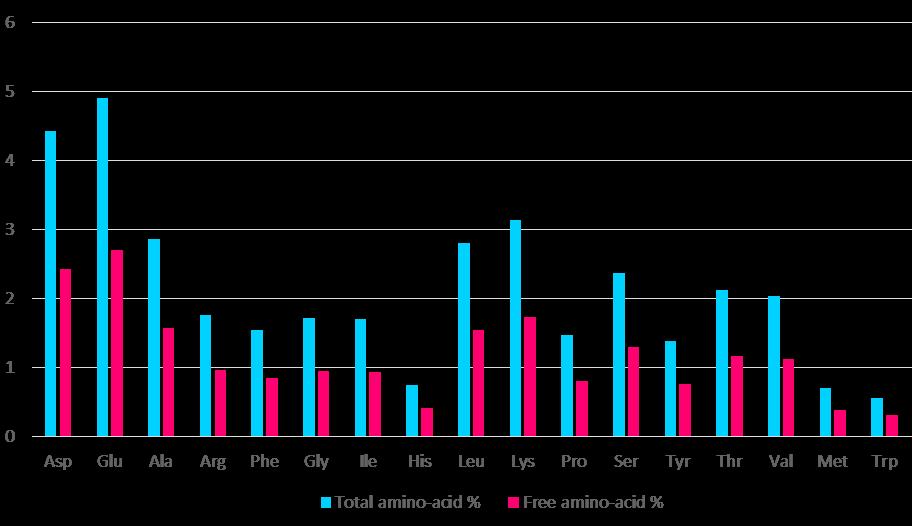
Gut microbiota:
• a multicellular and multifunctional organ. Maintaining a state of eubiosis over dysbiosis is very important. Threonine for example not only regulates protein homeostasis within the body, but also supports the growth of bacteria within the gut.
Today, we are seeing some of the key market drivers that are putting pressure on the supply of materials and ingredients for pet food. These include the increase in natural and human grade pet food products, competition between food and feed in terms of edible protein, supply chain challenges, price volatility, the rise of vegan and vegetarian trends, as well as increasing demands for more sustainable feed.
The development of new functional feed ingredients is a growing trend that can help address some of these concerns. As such, yeastbased ingredients are seen as promising solutions.
Conclusion
Gut immunity and anti-oxidation:
• the gut contains 70% of the immune cells within the body and many amino acids such as arginine, glutamine and tryptophan are important in maintaining gut immune system activity. Methionine serves as a methyl donor for several important processes, such as DNA methylation and polyamine synthesis, as well as its selenium storage function as selenomethionine. Cysteine is important for the production of compounds involved in immune response as well as selenocysteine being essential in many important enzymes, such as glutathione peroxidase, which is responsible for regenerating glutathione, when neutralising reactive oxygen species.
YELA PROSECURE application and growing pet food trends
Beyond the advantages of functionality and highly digestible nutrients, hydrolyzed yeasts are affordable and available in large volumes, which can be a limiting factor in the case of yeast extracts, for which the extra processing steps linked to the concentration of yeast soluble constituents mean higher costs and limited availability due
YELA PROSECURE can be used in all companion animal species, especially during early stages of development when digestive maturity has not yet been achieved. This is when it is most important to provide high quality and highly absorbable nutrients to promote animal growth and health maintenance. It can also fulfill two roles in one, as it offers a superior protein profile to other yeast products and can be used as an alternative to traditional palatants, or to lift the palatability profile of a food or supplement. YELA PROSECURE is an innovative feed material (Regulation (EU) No 68/2013) that can be used in all animal species and organic production under regulation (EC) No 2018/848.
References available upon request.
Francesca Susca, DVM, PhD

Pet Development Manager, Lallemand
Animal Nutrition
fsusca@lallemand.com
lallemandanimalnutrition.com
Pet Food SuPPlement 2022 Page 19
Total amino-acid content in Yela Pro Secure
Expert Insights; a 3-pronged approach to preventing mould and stabilizing kibble
By Sarah-Jane Godfrey, Pet Technical Manager, Trouw Nutrition GB
In addition to achieving good palatability, optimal mouth feel, and overall quality, petfood manufacturers are responsible for protecting the safety and stability of our four-legged friends’ diets. Steps taken during the petfood manufacturing process can help support shelf-life stability and ensure product quality while defending against mould growth.
Petfood production involves extreme processes that make it challenging to maximise quality targets like tastiness, production efficiency, and nutritional value, while keeping the product free from moulds. Extrusion processing tends to aim for a low final moisture level in the finished kibble. Though this tends to control mould growth, it can come at the cost of extrusion efficiency and reduced profitability. Identifying and achieving the proper balance of moisture content, throughput, and quality can support safety and quality parameters without sacrificing production efficiency. Below, we consider a three-pronged approach to achieve a high-quality product, production efficiencies, and profitable economics.
Manage the moisture profile 1.
During the extrusion and drying phases of production, kibble undergoes extreme thermal processes. A reduction in moisture content can adversely influence animals’ consumption preferences.
While compensating for moisture loss might sound as straightforward as adding more moisture, this action could increase the risk of mould developing and potentially reduce the final product’s shelf-life stability.
Managing the moisture profile of petfood considers both the moisture level and the water activity (aW) value. While aW and moisture content are related through the moisture sorption isotherm, they are not the same parameter. A high aW indicates the presence of free water that can support the growth of microorganisms including moulds. Various microorganisms also can feed on valuable nutrients, making them unavailable to the animal. Ingredients with high aW will affect ingredients with low aW and
as moisture balances out throughout the feed, desired attributes such as texture, durability, and palatability can be compromised.
Within the food industry, aW is used to effectively manage moisture and preserve food. Similarly, in pet food production, aW is becoming a standard parameter to guide formulation and produce even safer and better-quality kibble.
As aW and temperature are the most significant factors detracting from quality and longevity on the shelf, determining the ideal aW range for a pet food can help manage both attributes. As Table 1 shows, varying pet food products among different product categories can have comparable aW levels but different moisture content.
To preserve palatability and reduce the risk of mould growth, an ideal aW range is between 0.55-0.65. Values below this range tend to result in dry and hard kibbles detracting from palatability. There is also an economic consideration since aW that is too low indicates the manufacturer is over-drying the product. Pet food is generally sold on a weight basis, so reducing a pet food’s aW content will lower kibble weight and ultimately producers’ profits. However, a higher aW value creates more favourable conditions for mould growth and fat oxidation, which can reduce shelf-life.
To address these conflicting conditions and bring a balanced approach to meeting petfood quality objectives, Selko, the feed additive brand of Trouw Nutrition, developed Fylax Petfood. The product offers a potent solution for optimizing the moisture profile of petfood while reducing the risk of mould growth. Containing a synergistic blend of organic acids, buffering agent, emulsifier, and phytochemicals, Fylax Petfood includes a thoughtfully selected surfactant that lowers the surface tension of water. This effect allows moisture to penetrate deeper within the food particles and supports more even moisture distribution within the product to help achieve quality targets (Figure 1).
Page 20 Pet Food SuPPlement 2022
Commercial pet food Water Activity (aW) Moisture content, % Semi Moist Dog Food – Beef, carrots, and grains 0.744 17.0 Dry Kibble Dog Food – Adult regular Extra 0.618 9.3 Dry Kibble Dog Food – Adult small breeds 0.501 7.1 Dry Kibble Dog Food – Adult medium breeds 0.615 9.2 Dry Kibble Dog Food – Puppy 0.652 9.4 Dry Kibble Dog Food – Puppy sensitive 0.560 7.4 Dry Kibble Cat Food – Adult economy 0.407 6.4 Dry Kibble Cat Food – Supermarket brand 0.364 5.3 Dry Kibble Cat Food – Adult cats 0.506 7.4 Dry Kibble Cat Food – Premium adult 0.461 6.3 Dry Kibble Cat Food – Premium kitten 0.450 6.0 Dry Kibble Cat Food – Cat adult 0.541 7.2 Table
Activity
moisture survey of commercial types of pet food ranging from economy to premium brands
1. Selko Water
and
deter mould growth and is designed to deliver a sustained effect that can withstand commercial environments’ extended shelf-life requirements. Studies show that its active ingredient to deter mould growth is stable even at the high temperatures used in petfood production (Figure 3).
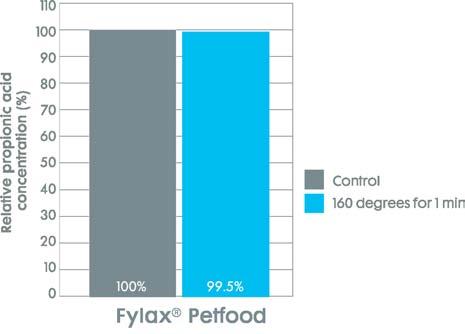

Synergistically support safety, deter mould, and meet 2. shelf-life requirements
As the commercial petfood market generally prefers a shelf life up to 24 months, assuring a product’s longevity and quality can pose challenges with regards to mould development.

Adding a mould inhibitor during preconditioning can help safeguard shelf life and defend against mould growth. ActiProp technology in Fylax Petfood effectively reduces mould growth while helping to maintain product quality and freshness (Figure 2). ActiProp increases the porosity of moulds’ cell walls, which allows its components to deploy a destabilising effect on the cell membrane. As this action allows better access for organic acids, the cell’s internal pH decreases, inhibiting growth and eventually killing the mould cell. Four key components delivered at the most effective quantities underlie this mode of action.

The mould inhibitors added during preconditioning must survive the extruder’s extreme environment. ActiProp® technology is designed to
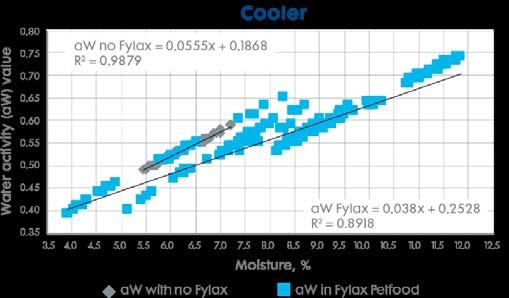
Ensure efficacy with accurate dosing and 3. application
Accurate dosing and application processes during petfood manufacturing are essential to a solution’s efficacy. Selko’s Feed Processing & Quality programme combines products and services with effective dosing solutions to support accurate, safe, and continuous product application during petfood production.
Dosing and application services are value-added components included in the programme and can be fully automated and integrated into feed production lines. A variety of systems are available to meet the nuances of customers’ production environments. Additionally, remote access capabilities support quick analysis to help guide dosing decisions and detect any necessary interventions.
A three-pronged approach can guide safe, palatable, and highquality pet food manufacturing supporting both pets and the economics of petfood production.
*The product mentioned in this article is not available in USA
References available on request
Contact: sarahjane.godfrey@trouwnutrition.com
Sarah–Jane Godfrey is a graduate from the University of Nottingham where she obtained a BSc in Agricultural and Food Sciences with specialization in Animal Science. She has over 20 years of experience working in the animal feed sector initially working as a pig and poultry nutritionist, latterly concentrating on her passion for companion animal nutrition. Sarah-Jane has worked for 14 years in the specialist premix sector and brings with her a variety of experience supporting customers in the European region on pet nutrition, premix design, regulation, market trends evaluation and new product development.
Pet Food SuPPlement 2022 Page 21
Figure 1. Fylax Petfood supports even moisture distribution in commercial pet food production.
Figure2. ActiProp technology in Fylax Petfood shows a synergistic effect on mould inhibition.
Figure 3. Propionic acid in Fylax Petfood remains stable at extrusion temperatures
Beta-1,3/1,6-glucans promote well-being of obese dogs
By Pauline Rovers-Paap, Central Technical Manager, Orffa Additives
Obesity can be considered as one of the most common nutritional disorders in dogs and cats. Caloric restriction is often the solution to lose excessive weight, however success is difficult as the fourlegged fellow, with friendly eyes, will beg for more food from his owner. Several clinical chronic health problems are correlated to being overweight. The adipocytes, cells specialized in fat storage, are metabolically active and responsible for inflammatory mediators, resistin and leptin. One of the complications of being overweight is insulin resistance, the low sensitivity of body cells to respond to insulin for the uptake of glucose as an energy source.
This article discusses the positive effects of a highly purified beta-1,3/1,6-glucan source in obese dogs with insulin resistance. In the boxes additional information is provided about differences between cereal and yeast beta-glucans, and the beneficial effects of yeast beta-1,3/1,6-glucans in other animal species with disorders related to the glucose metabolism.
Measuring efficacy of beta-1,3/1,6-glucans in obese dogs with insulin resistance
At the University of Sao Paulo, Brazil, the effect of yeast beta1,3/1,6-glucans was investigated in privately owned obese dogs with clinically proven insulin resistance (1). Different parameters related to glucose and lipid homeostasis, inflammatory markers and satiety were evaluated and compared to healthy lean dogs. Figure 1 shows the design of the dog study. In the acclimation period of 15 days (Period 1), 7 obese dogs (body condition score 9/9) and 7 lean dogs (body condition score 5/9) received the same maintenance diet (control diet). The daily amount of food was calculated for each individual dog
to maintain body weight. Over the next 90 days (Period 2), the trial continued with only the obese dogs. In this period, the obese dogs received the same control diet, with the addition of 0.1% MacroGard® (Biorigin, Brazil), a highly purified yeast beta-1,3/1,6-glucan source. Basal blood samples were taken for evaluation after the 15 days acclimation period and at the end of the 90 days of beta-1,3/1,6glucan supplementation. At both timepoints an intravenous glucose tolerance test (IGTT) was also performed.

Glucose and lipid homeostasis
Being overweight increases the risk for metabolic disorders such as insulin resistance. Insulin resistance is characterized by high glucose and insulin levels in the blood. Body cells become less sensitive for insulin and thereby, inefficient to take up glucose from the blood and to use this glucose as an energy source. In the described dog trial, obese dogs receiving beta-1,3/1,6-glucans for 90 days showed important changes in metabolic parameters related to insulin resistance. Inclusion of 0.1% MacroGard® in the diet significantly reduced basal glucose, basal insulin, cholesterol and triglycerides concentrations in the blood of the obese dogs compared to the initial values (Figure 2). Where basal insulin shows an intermediate value, the other values were reduced to such an extent, that the levels were even similar to those of lean dogs. After the intravenous glucose addition in the IGTT, the blood glucose and insulin levels were still high, however, both the glucose and insulin peak tended to be lower after the supplementation of beta-1,3/1,6-glucans to the obese dogs.
Reduction of glycaemic values (glucose and insulin), cholesterol and triglycerides are in line with the results found in laboratory
Page 22 Pet Food SuPPlement 2022
Figure 1: Timeline of the study measuring the effect of beta-1,3/1,6-glucans in obese dogs with insulin resistance, and comparing results with lean individuals.
animals (2) (3) (Read box ‘Glucose and cholesterol control by beta1,3/1,6-glucans in other species’). Interestingly, in healthy animals with a normal glucose homeostasis, beta-1,3/1,6-glucans do not have any influence on these metabolic parameters (3) (4). However, when animals show hyperglycaemia, beta-1,3/1,6-glucans are able to reduce glycaemic values, even to the reference range of healthy individuals (1) (4).
Inflammatory status
Adipose tissue, possibly in combination with obesity associated comorbidities, are responsible for the production of many inflammatory mediators and adipocytokines. As a consequence, obese individuals often have a low-grade chronic inflammatory status. Weight loss is an effective solution to reduce the secretion of the inflammatory cytokines.
Even without performing a weight loss program in the dog trial, 90 days supplementation with MacroGard® resulted in lower serum TNF-α concentrations in the obese dogs, an important proinflammatory cytokine. Although not significant, other inflammatory markers IL-6 and C-reactive protein were also lower in the obese dogs after supplementation and became closer to the reference values found in lean dogs. Controlling the effects of low grade inflammation is noticed in other studies with MacroGard® as well, including trials on periodontitis (3) (5), osteoarthritis (6) and atopic dermatitis (7).
Satiety
Weight loss is the recommended treatment for obese animals. However, caloric restriction of pets is difficult, as it consequently leads to the animal seeking and begging for food and this behaviour may often compromise the owner and their compliance for restricted feeding. Dietary strategies to stimulate satiety without additional calories are of great interest for managing weight reduction of companion animals.
The release of appetite-regulating hormones plays an important role in controlling the caloric intake by pet animals. Both PYY and GLP-1 prolong the gastric emptying time and the small intestine transit time, and are known to reduce appetite and promote satiety.
In the obese dogs from the trial, MacroGard ® seemed to increase the release of PYY. Despite the large numerical difference between the mean PYY value before and after supplementation in the overweighted dogs, the observed difference was not significant.
Glucose and cholesterol control by beta-1,3/1,6glucans in other species
Not only is a large part of the pet population overweight, obesity and diabetes are also a main public health issue in humans and many research projects with laboratory animals as human models are focussing on nutritional solutions. A Brazilian research group of the Federal University of Lavras evaluated the use of highly purified beta-1,3/1,6-glucans from yeast (MacroGard®) in different settings and occasions of obesity and diabetes. In type 2 diabetic rats receiving a high fat diet, the effects of exercise and beta1,3/1,6-glucans consumption were investigated. Independent of the physical exercise, ingestion of beta-1,3/1,6-glucans significantly optimized glycaemic parameters like lower fasting blood glucose and HbA1c levels. The beta-1,3/1,6-glucans also reduced predisposition to atherosclerosis, by significantly lowering levels of triacylglycerols, total cholesterol and LDL-C in the blood, while increasing HDL-C (also known as the ‘good’ cholesterol), resulting in an improved atherogenic index (2).
Completely in line with these results, in another rat study, consumption of highly purified beta-1,3/1,6-glucans (MacroGard®) lowered blood glucose, total cholesterol and triacylglycerols in diabetic animals with and without periodontal disease (3). Furthermore, in this study treatment with this beta-1,3/1,6glucan source reduced the release of degradative enzymes and inflammatory markers (e.g. COX-2, NF-kB). Independent of the diabetic status, alveolar bone loss was reduced in animals with gingivitis that received beta-1,3/1,6-glucans. Attenuated alveolar bone loss is also demonstrated in other studies with beta-1,3/1,6glucans in Wistar rats (8) and cats (5). All these promising results promote further research into the effects of beta-1,3/1,6-glucans in pet animals with excess of body weight or other comorbidities.

Pet Food SuPPlement 2022 Page 23
Figure 2: Effect of beta-1,3/1,6-glucans supplementation on metabolic parameters in obese dogs with insulin resistance, compared to values in lean dogs (P<0.05).
However, appetite regulating hormone GLP-1 increased significantly in obese dogs after receiving beta-1,3/1,6-glucans in their diet. The increase of satiety hormones could correlate to the practical observations in this study, where four out of the seven obese dogs were eating more slowly, presented food leftovers as the study progressed and why none of the dogs showed begging behaviour attempting to obtain more food.
Conclusion
Beta-1,3/1,6-glucans have proven to be beneficial for overweight dogs. Inclusion of 0.1% of highly purified beta-1,3/1,6-glucans
Cereal or yeast beta-glucans?
from yeast in the diet can improve glucose and lipid homeostasis, inflammatory status and satiety in obese dogs with insulin resistance. These results are in line with studies in other animal species. Although the mechanisms require further investigations, cereal and yeast betaglucans could be complimentary to each other in a weight control diet, as the carbohydrate structures have different physiological properties in the digestive tract. MacroGard® is a natural ingredient that has proven to be beneficial for weight loss programs and in diets for obese pet animals.
References are available on request
For centuries, cereal and fungal beta-glucans have been used for medicinal and cosmetic purposes. Beta-glucans are natural components of the cell walls of plants, some bacteria and yeasts. Glucans are polymers that contain glucose as the only building block. The specific way of how glucose molecules are connected to each other, influences the physiological properties of each specific glucan structure. Figure 3 shows a glucose molecule, and the numbers refer to the location where one glucose molecule can be linked to the next glucose molecule.
Beta-glucans found in plants and cereals are predominantly linear and have branches with ß-1,3/1,4-type linkages. These ß-1,3/1,4type glucans are soluble with low molecular weight. In contrast, beta-glucans from yeast and fungi are insoluble, and have a linear ß(1,3) backbone with side ß(1,6) branches (Figure 3).
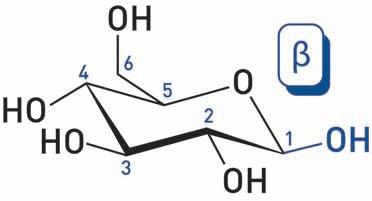

Figure 3: Glucose molecule showing the notation of carbon numbering for a binding place to the next glucose molecule. Below the typical beta-1,3/1,6-glucan structure from yeast derived beta-glucans is shown.
Oat beta-glucans are water-soluble fibre and well known for their property to lower blood glucose and cholesterol. The positive effects on these parameters are probably related to the physicochemical interactions between the oat beta-glucans and the digestive bolus in the intestinal tract. These water-soluble fibres increase the viscosity of the digesta, which delays gastric emptying and forms a gelatinous layer in the small intestine which reduces the uptake of nutrients like glucose. Further on in the digestive tract, oat glucans can also act as a prebiotic, where they are fermented and function as a growth substrate for beneficial bacteria.
Beta-1,3/1,6-glucans from yeasts are known for their immune modulating properties and are also actively investigated for their beneficial effects on human and animal health. Recently more research is performed on health problems related to obesity, insulin resistance and associated complications. Excess of adipose tissue and inadequate control of blood glucose levels are well-known factors that initiate or maintain a low-grade inflammatory status in the body. This explains why overweight or diabetic individuals often have other complementary health issues (e.g. gingivitis, osteoarthritis). Knowing the immune modulating capacities of yeast derived beta-1,3/1,6-glucans, makes these natural food components attractive for further research on obesity and related complications.
Page 24 Pet Food SuPPlement 2022





























MACROGARD ® Support health and well-being of our pet animals Engineering your feed solutions www.orffa.com - Follow us on Highly purified from a unique yeast source Balance the natural immune system Best documented beta-1,3/1,6-glucan For more information Sam Phelps Technical Commercial Manager +44 7761 758284 phelps@orffa.com
How biomega® is helping the pet food industry work towards zero waste
Waste is driving a triple planetary crisis of climate change – according to the United Nations Environment Programme (UNEP).

For years, our food production and consumption model followed a take-make-dispose linear system. However, those days are now over. With a bigger push for a circular economy, those in agriculture and aquaculture are adopting new and innovative techniques to begin overhauling global food, feed and pet food systems. But we have a long way to go. In its latest report, UNEP found that an estimated 931 million tonnes of food (17% of total food available) was discarded as waste by households, retailers and food service outlets in 20191
Fortunately, initiatives like the Upcycled Food Association, are working to prevent food waste on this scale in the future. Under current estimates, the initiative could prevent 318 thousand tonnes of food waste per year2. This rising imperative for zero waste solutions has revolutionised the way pet food is manufactured. Processes such as rendering has enabled the prevention of up to 50% of meat animal waste, with parts used to make protein ingredients for pet food, thereby reducing greenhouse gas emissions3. Then, there are businesses like biomega® that use leading-edge biotechnology to transform salmon parts into premium ingredients for pet food manufacturers.
The turning point
The company’s CEO, Stig Petersen, recently shared his unique insight into how zero waste principles are evolving within the industry, particularly in response to changing consumer demands and legislation.
“For decades, high quality raw materials from the marine sector have delivered ingredients for feed and pet food next to human food, health and nutrition. We’re at a real turning point in driving the key issue of sustainability, where a larger part of these raw materials can be made available for human health and nutrition,” commented Petersen. “What is meant to be food must be utilised for food where possible and thereby sustainability, in the context of the health and nutrition sector, is certainly no exception. Innovation in process design and manufacturing is at an all-time high and the consumer is more engaged than ever before. It’s clear that logical and robust circular economies are the way forwards, both commercially and for protecting the future of the sector.
“Importantly for brands and product developers, as global consumers get savvier, the umbrella term ‘sustainability’ doesn’t hold the same commercial weight. Consumers want demonstrable proof and action. There’s a marked move towards building a stronger circular economy, removing waste from the equation. This covers areas such as manufacturing and logistics, but innovation can also be found in ingredient sourcing and production too. It’s likely that over the coming year, we will see massive acceleration in technology that directly addresses circular economy principles.”
Reduce, reuse, recirculate
Championing zero waste operations is part of the Norwegian-based company’s ethos – and they are not alone. According to Euromonitor research, many top global packaged food and pet food players have already defined their sustainability approach. Between 2020 and 2021, 80% of those companies identified had committed to reducing impacts on the environment with emissions-based targets4. This included a stronger focus on renewable energy, sustainable and regenerative agriculture and carbon neutrality.
“We’re proud to be well positioned regarding sustainability at biomega®,” continues Petersen. “Reducing the environmental burden of business has been crucial to our activities and we’ve been in the fortunate position of leading by example. For instance, our business has been certified by aquaculture environmental organisations previously and we have now started the process to achieve ASC certification as testament to our responsible operations. This includes
Page 26 Pet Food SuPPlement 2022 Closing
the loop:
sourcing from approved Atlantic salmon and optimising the use of marine resources.”


For biomega®, location is pivotal to its success. The biosciences business has taken additional steps to ensure its operations are keeping carbon emissions to a minimum. As such, it is currently in the final stretches of building its new biorefinery at the Port of Hirtshals, Denmark, which is on track for completion this summer.
The new multi-million EUR biorefinery will aim to support petfood and human nutrition manufacturers by extending the company’s capacity by a minimum of 20k MT raw materials. It forms part of a major investment by AMERRA Capital Management, which acquired biomega® in 2017, and Mirova Natural Capital.
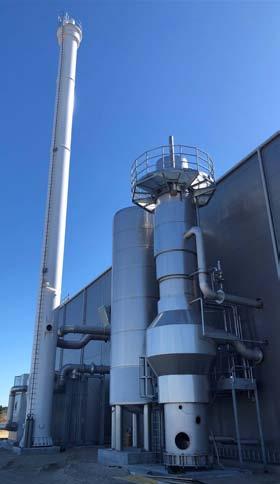
“With the Nordic region continuing to lead from the front to become 100% self-sufficient in terms of its gas supply, the Hirtshals biorefinery
sources its gas directly from Danish distribution, of which 30% is sourced from biogas,” says Petersen. “Due to its location, any surplus energy will also be circulated around the port for future operational use. Aside from energy consumption, our new biorefinery is also located closer to the source of our raw material, further minimising our carbon footprint.”
Meeting net-zero emissions targets
Known as the green port development, the large-scale project aims to make the Port of Hirtshals a pioneer in sustainability. By 2027, it hopes to offer green energy as standard and operate a smart energy system, where surplus heat can be reused as part of industrial symbiosis5 Projects like these form part of Denmark’s pledge to reach its 2030 target of 70% emissions reduction and climate neutrality by 20506 For biomega®, the biorefinery also assists in Norway’s push to reach net-zero targets by 2050 too7
“By upcycling undervalued sidestreams through our enzymatic hydrolysis process into high-quality, premium ingredients for use in petfood, aquaculture and human nutrition applications, biomega® is a part of the responsible consumption and production movement,” explains Petersen. “Aligning with the UN Global Compact and sustainable development goals, we are forging a path that enables pet food manufacturers and brands to choose zero waste from the outset.”
We are biomega®. Upcycling salmon parts into high value healthy petfood ingredients, which includes our Salmigo® range of proteins and peptides.
• Minimal environmental damage and zero waste

• High quality and consistent yield due to 24/7

• Cost and resource
• High quality raw materials
• Located close to sustainable salmon rest streams
Value vitality. Value today. Value tomorrow.
by nature. Circular by process. Our story begins with a circular vision and ends with
Circular
To find out more about our sustainable hydrolysed products, visit biomegagroup.com or email sales@biomegagroup.com
With more than 20 years of investment in its research and development into sustainable processes, biomega® is helping its customers and suppliers work towards a fully traceable and circular marine production system. Its biorefinery in Norway – and soon Denmark – operate to a 24/7 production continuity model using enzymatic hydrolysis. The patented process delivers minimal environmental damage due to its gentle separation system, while utilising every part of the raw material. The company’s year-round production processes seek to deliver consistent yield without hindering quality, making it much more cost-effective for petfood and aquafeed businesses.
All-natural ingredients
Salmigo® is the company’s brand name for its salmon proteins and peptides used in premium petfood applications. These salmon peptides are processed from fresh Atlantic salmon and contain approximately 90% proteins in the form of peptides and free amino acids. As a highly digestible nutritional source of protein, the Salmigo® range has a high biological value, featuring long-chain EPA (eicosapentaenoic acid) and DHA (docosahexaenoic acid) omega-3 fatty acids, natural vitamins and astaxanthin.
“Our manufacturing process enables pet food brands and retailers to benefit from a high-quality peptide for food, treats and snacks. The process involves no added preservatives and retains the superb nutritional benefits from the raw materials, which delivers excellent palatability for cats and dogs,” says Petersen. “Our latest research highlights Salmigo® Protect L60, for instance, can potentially replace
glycerine – a nutritionally devoid ingredient – in semi-moist pet snacks. This is a major advantage for petfood applications that want to promote highly nutritional, natural ingredients in their range.”
With all-natural ingredients, companies such as biomega® are not just focusing on what’s most important to pet food brands, but what is the most authentic and sustainable way to move towards a world without waste. Even global consumer surveys suggest that six in ten people say that where and how a product is made is very important to them8

Here, the takeaway is clear, as Petersen concludes: “Collaboration to close the loop is needed if we are to reach net zero by 2050 – and sharing that insight is key to preserving our planet’s natural resources. If we close the knowledge gap, closing the loop is not far behind.”
References
1. UNEP, ‘Why humanity needs to overhaul its food system’, February 2022
2. Upcycled Food Association via Pet Food Processing, Sustainable certification will prevent 703 million pounds of food waste, January 2022
3. North American Renderers Association via Pet Food Processing, ‘It’s a necessity’: finding more sustainable ingredient sources for pet food and treats, April 2021
4. Euromonitor International, Passport, Megatrends: From Sustainability to Purpose – Refocus on the planet, March 2021
5. Greenport North, Green value propositions in the Port of Hirtshals, 2022
6. CCPI, Denmark, 2022. https://ccpi.org/country/dnk/
7. Reuters, Norway wealth fun to push firms to have net-zero targets, April 2022
8. Bake Mag, Cargill Trend Tracker Insights, April 2022
Biomega Group is pleased to announce the appointment of Dr. Silke Middendorf to the role of Chief Commercial Officer (CCO).
In the next significant commercial step forward for the business, Dr Middendorf will be responsible for leading the marketing and sales strategies of the business and guiding growth projects to completion, reporting to the company’s Chief Executive Officer.
Holding a PhD in Biophysical Chemistry and bringing significant multinational and intercultural experience to the business, Dr Middendorf has a proven track record in driving commercial strategy at large globally operating businesses. Dr Middendorf’s skills and competencies are a perfect fit for Biomega as the business continues its ambitious expansion through the global nutrition and pet care industries.

Stig Petersen, CEO at Biomega, comments: “We are excited to welcome Dr Middendorf to our team and look forward to all the positive contributions she will no doubt make to our business. Silke’s track record speaks for itself, driving sales and marketing development at health and nutrition giants such as Pfizer and Symrise.
“We are very much a culture-driven business, and Dr Middendorf – and her desire to make a real difference – is an ideal fit for our team in terms of our culture, values and mission. We look forward to seeing Dr Middendorf make her mark on the long-term commercial journey of Biomega.”
Dr Middendorf adds: “I am extremely pleased to join the talented Biomega team as the company’s new Chief Commercial Officer. The Biomega business has a strong focus on connecting life sciences and nutritional ingredients with sustainability and is offering something fresh and unique to the market. I look forward to playing my part in the international growth of the business and helping to raise the business to even greater heights.”
Page 28 Pet Food SuPPlement 2022
Biomega appoints Dr. Silke Middendorf to Chief Commercial Officer role
Seaweed as a Premium Natural Prebiotic for Dogs
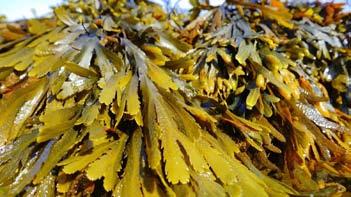
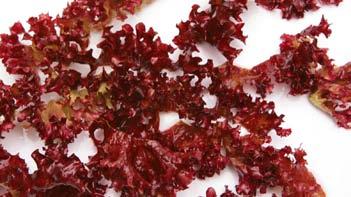 By Dr Jason Sands; Head of Nutrition, Ocean Harvest Technology
By Dr Jason Sands; Head of Nutrition, Ocean Harvest Technology
Marine macroalgae consist of three diverse Phyla, the Phaeophyta (brown) Chlorophyta (green) and Rodophyta (red) seaweeds. Numerous published reports and decades of successful use have highlighted the potential of seaweeds as rich sources of bioactive compounds with potential applications in animal nutrition. Among the bioactive compounds highlighted in seaweed, the polysaccharides are of particular interest for their specific prebiotic effects on the gastrointestinal (GI) microbiota (de Jesus Raposo et al 2016; Sardari and Karlsson, 2018; Cherry et al., 2019; Shannon et al., 2021).
The GI microbiota has been shown to affect the availability of nutrients in the intestine, the immune response and to provide signals that effect behaviour of the host (Schmitz and Suchodolski, 2016). Under normal diet and health conditions the microbial community has a specific composition. Poor diet, stress, infection, or other environmental changes can alter the normal profile of the GI microbiota.
Prebiotics are defined as non-digested food components that, through the stimulation of growth and/or activity of a single type or category of microorganisms residing in the GI tract, improve the health status of the host animal (Gibson and Roberfroid, 1995). To be considered a prebiotic the food component must: 1) be resistant to gastric acidity and hydrolysis by mammalian enzymes and subsequent gastrointestinal absorption; 2) be subject to fermentation by intestinal microflora; and 3) selectively stimulate the growth and/or activity of the intestinal bacteria that contribute to the health and well-being of the host.
Unique polysaccharides, complex carbohydrate polymers or fibre found only in macroalgae, account for around 30-75% of the dry weight of seaweeds, where they serve in a structural role in cell walls (Xu et al, 2017). Green, red, and brown algae contain a significant proportion of sulfated polysaccharides generally not found in land-based plants (Berri et al, 2017). Soluble polysaccharides comprise around 50–55 % of total fibre in commonly used green and red macroalgae and 65–85 % in brown macroalgae (Lahaye 1991). These soluble polysaccharides are particularly effective prebiotics in animals (Hentati et al., 2020).
Seaweed Polysaccharide Diversity

Seaweeds contain many di ff erent polysaccharides, with similar contents of total carbohydrates in brown and green seaweeds, whereas red seaweeds tend to be slightly lower. In addition to solubility as a functional property, sulfated polysaccharides (SP) of seaweed origin are unique in that they combine the bioactivities of polysaccharides with the additional bioactivity of the attached sulfate group. The extent to which seaweed polysaccharides are sulphated differs among the main seaweed families. For example, the ulvans from green algae are extensively sulphated, whereas alginates, the predominant polysaccharide in brown seaweed, are not sulphated. The diversity of seaweed polysaccharides indicates that a combination of seaweeds would provide a more diverse source of prebiotic activity compared to using a single seaweed as a feed supplement.
Recent advances in genomics techniques have shed new light on the prebiotic effect of seaweed polysaccharides on the GI microbiota profile and related physiological effects (Schmitz and Suchodolski, 2016). For example, the Firmicutes phyla account for around 30% of the colonic and faecal microbiome in healthy dogs (Suchodolski et al. 2008). The order Clostridiales were found to be around 18% of the bacterial sequences, with Clostridium cluster XIVa accounting for around 50%. It is interesting to note that Clostridium cluster XIVa includes Eubacterium, Roseburia and Ruminococcus spp., some of the important fermenters of dietary fibre in the hindgut. Alterations in the profile of the microbiota is a key factor in the development of acute or chronic GI disease (Schmitz and Suchodolski, 2016). Studies show
Pet Food SuPPlement 2022 Page 29
that dogs with acute diarrhoea had increased Clostridia perfringens, Eschericia coli, Lactobacillus and Enterococcus spp. and reduced abundance of groups such as Faecalibacterium, Ruminococaceae and Blautia spp. that make up the normal colonic microbiota. In addition, the sulphated ulvans and their oligosaccharides in the green seaweed Ulva spp. are known to possess strong immune-modulating activities (reviewed by Wany et al., 2014).
Practical applications of Seaweed prebiotics in dogs
Reducing Mouth Odour
Mouth odours can indicate several health conditions, one of which is bacterial infection of the oral cavity. If this happens, the sulphated polysaccharides in seaweed which show antimicrobial activity can help. The gelling properties of seaweed polysaccharides also appear to enhance their dental health effect. The consumption of edible treats containing brown seaweeds such as Ascophyllum nodosum efficiently decreased plaque and calculus accumulation in dogs (Gawor et al, 2018). Dogs treated with A. nodosum extract also exhibited significantly better oral health status (e.g., better oral health index and gingival bleeding index) compared to a placebo-control group.
Suppression of harmful GI bacteria
Sulphated polysaccharides extracted from different seaweeds such as Laminaria japonica, A. nodosum or Undaria pinnafitida have been demonstrated to have an inhibitory effect on the growth of pathogenic bacteria (De Jesus Raposo et al, 2015). Extracts rich in either laminarin or fucoidan fibres isolated from Laminaria spp decreased the fecal E. coli populations in pigs and reduced bacterial load in raw meat products (McDonnel et al, 2010).
Increasing nutrient availability
The soluble fibre from seaweed polysaccharides are fermented by beneficial bacteria in the hindgut, producing short chain fatty acids (SCFA) that are the primary energy source for the colonic intestinal cells. Butyrate, one of these SCFA, also serves as a key signalling compound in the hindgut by controlling the intestinal defence system (Schmitz and Suchodolski, 2016; Pilla and Suchodolski, 2020). This improved gut health in the presence of seaweed fibres can improve nutrient uptake, leading to a healthier and more active pet.

Reducing Faecal Odour
In addition to being unpleasant for dog owners, intense faecal odours are often an indication of maldigestion, dysbiosis (a disturbance of the normal microbiota profile) or the presence of pathogenic bacteria. These intense faecal odours are due to bacterial breakdown of undigested proteins, producing ammonia, amines, indols, phenols and volatile sulphur-containing compounds (Hesta et al., 2003). Diet type, particularly dietary soluble fibre, can impact faecal odour. The lack of soluble fibres, which are indigestible in the stomach and intestines, to provide substrates for the beneficial bacteria in the colon or hindgut is the principal cause of dysbiosis. Other factors include the use of antibiotics and infection by pathogenic bacteria. The high content of soluble fibre in seaweeds provide an excellent substrate for the bacteria in the hindgut that produce energy and vitamins for the animal and create a favourable gut environment.
Experience with OceanFeed Pet
Ocean Harvest Technology recently tested OceanFeedTM Pet, a propriety optimized blend of green, red, and brown seaweeds, with a total of 50 family pets varying in breed, size and age. These 50 dogs
Page 30 Pet Food SuPPlement 2022
Figure 1: The polysaccharides in brown, green and red seaweeds:
Green
Red Brown
were fed OceanFeedTM Pet mixed with their standard diet for 4 weeks. At the end of the trial, 88% of the dogs were reported to have improved digestive health, including reduced diarrhoea and firmer stools. The same percentage, 44 out of 50 dogs, were also reported to have improved coat or skin condition, such as softer or shinier coats and reduced flaking. Twenty of these dogs were reported to exhibit improved energy or stamina, particularly during hot weather, while 15 were reported to have better smelling breath, likely due to the previously discussed prebiotic effect of seaweed across the GI tract.
But beware Mineral Contents!
Seaweeds can accumulate different minerals to a greater or lesser extent, depending on species and growing conditions and location. Two minerals, iodine, and arsenic are of particular concern with respect to animal health, particularly for brown seaweed. The iodine content in for example A. nodosum, commonly known as kelp, can vary from around 500-900 mg/ kg (Table 1). With an EFSA (2005) Maximum Tolerable Level of 4 mg/ kg (ppm) for iodine in dog diets, this means that kelp inclusion should be kept under 5 g/kg (0.5%) of dog food. However, green seaweeds such as Ulva (OceanFeedTM Green) and seaweed blends such as OceanFeedTM
Pet have much lower iodine levels and can be safely included at up to 50 mg/kg (5%) of the dog food.

Brown seaweeds can also contain high levels of arsenic. EU directive 2002/32/EC (Official Journal L 140, as amended in L 328) on undesirable substances in animal feed has defined the maximum level of total arsenic allowed in seaweed meal and materials derived from
seaweed for animal feed as 40 mg/kg. While kelps can often exceed this figure, green and appropriate blends of seaweed can fall well below this maximum level (Table 1).



Table 1. Attributes of brown, green or blended seaweeds
Green seaweed such as Ulva spp, known as ‘sea lettuce’ and used in OceanFeedTM Green, is widely used as a food condiment and is more palatable than standard kelp (Table 1). However, for gut function a blend of green, red and brown seaweeds, such as in OceanFeedTM Pet, with the resultant spectrum of beneficial fibres and other bioactives, is optimal.
References: available upon request
Pet Food SuPPlement 2022 Page 31
Seaweed Ascophyllum nodosum OceanFeedTM Green OceanFeedTM Pet Brown Green Blend of Green, Red & Brown Iodine (mg/kg) 500-900 10-40 140-150 Arsenic (mg/ kg) 35-45 4-5 7-10 Relative palatability Poor High Medium Relative gut function Medium Medium High
Manufactured by Ocean Harvest Technology www.oceanharvesttechnology.com Irish Facility 00353 (0) 93 51 807 Available in Pellet, Crumble and Meal forms 100% Premium blend of Red, Green and Brown Seaweeds Improves gut balance Prebiotic soluble fibre A good source of Omega-3 Improves nutrient and mineral uptake Improves firmness of stools Improves digestive health Improves coat condition Better dental hygiene NATURAL PRODUCT SUSTAINABLY HARVESTED
THE POWER OF POSTBIOTICS Giving pets the best health support

 With Alana Harvey-White, Commercial Manager Pet and Equine, Cargill
With Alana Harvey-White, Commercial Manager Pet and Equine, Cargill
The development and availability of functional ingredients are contributing to enriched pet food diets. Included in these ingredients are pre- and probiotics, and now the newly defined postbiotics. The core function of these is the association of microbes and the foods they feed on, which provides a favourable outcome.
products are backed by research that includes more than 425 controlled research studies and 120 peer-reviewed publications across all livestock, pet and aqua species.
Using innovative fermentation techniques and proven analytical methods, the company produces postbiotics in a highly controlled environment to ensure a consistent high quality and reliable product. They are produced through the precise fermentation of inputs – typically bacteria and yeasts and a proprietary nutrient-rich media – to generate a blend of more than 20 beneficial metabolites. These metabolites include amino acids, vitamins and short-chain fatty acids, which are known to support health.
They are also proven to be stable through all typical manufacturing processes, such as pelleting, extrusion, retorting and aseptic packaging. “This is an advantage compared to many other supplements, and this is why the innovation of postbiotics has been a game-changer particularly in pet food,” adds Mrs Harvey-White.
During the past 18 months, a postbiotic has been more accurately defined. The International Scientific Association of Probiotics and Prebiotics (ISAPP) describes a postbiotic as ‘a preparation of inanimate microorganisms and/or their components that confers a health benefit to the host’.
“Postbiotics may contain intact inanimate microbial cells and/or microbial cell fragments or structures with or without metabolites as end products,” says Alana Harvey-White. “They differ from pre- and probiotics in that they are the product of the two, when produced in the animal.”
Prebiotics are generally fibres found in plant cell walls. They serve as fuel for beneficial organisms in the gut.
Probiotics, such as live beneficial bacteria and yeasts, are found in the gut and provide ‘factories’ that can use prebiotics to make metabolites. The metabolites (postbiotics) are then utilised by the host animal, and have been shown to be highly beneficial to its health and well-being.
“The effectiveness of in vitro pre- and probiotics, and therefore postbiotics, can be impacted by the health and stress status of the pet,” adds Mrs Harvey-White. “The great benefit of a postbiotic supplement is its consistency and stability.”
Diamond V, a Cargill company, has been developing and producing ingredients, now defined as postbiotics, for more than 75 years. Its
First for pets
Cargill’s Diamond V developed and marketed the first such product for pets, called TruPet. TruPet has been proven to be effective in supporting immunity, digestion and vitality in dogs.
“It is a leader in fermentation and postbiotic technology,” says Mrs Harvey-White. “TruPet contains a unique blend of bioactive compounds that work with the pet’s biology to support beneficial bacteria and balance the gut microbiome. The significance of postbiotics in pets, as shown by trials using TruPet, is more active dogs, a healthy digestive system with improved gut microbiome and less smelly faeces, and a better-supported immune system,” she adds
Page 32 Pet Food SuPPlement 2022
TruPet put to the test
Species-specific trials show that the postbiotic additive supports immunity and promotes gut and overall health in dogs.
Trial results showed that dogs fed a diet with TruPet had lower levels of key indicators that are known to increase when the immune system is activated, including white blood cells, neutrophils, TBARS and TNF-a.
Figure 1 shows the impact of including the TruPet postbiotic on antioxidant support and immunity.
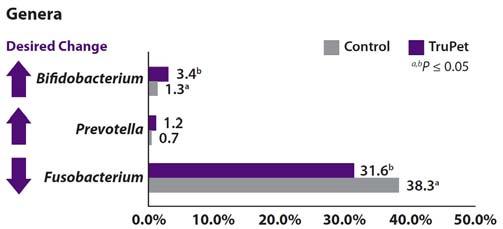
A similar positive effect was seen in gut health where TruPet was included in dog diets. There was a beneficial shift in gut microbiota compared with dogs fed the control diet, as shown in Figure 2. Figure 2 also shows that dogs fed on a TruPet diet were 50% more likely to have a desirable faecal score, reflecting improved digestive and gut health.
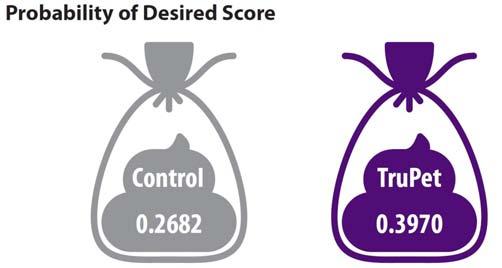
“Where the gut health and immune systems are functioning optimally, dogs have more energy for activities such as playing and running,” adds Mrs Harvey-White.
A 2018 study showed that dogs fed diets that included the TruPet postbiotic were 15% more active than control dogs when running a set distance following a trainer’s vehicle. These results are shown in Figure 3
Cargill’s postbiotics have been proven to be highly appetising with food supplements containing its postbiotic preferred almost 2:1 compared with the control product.

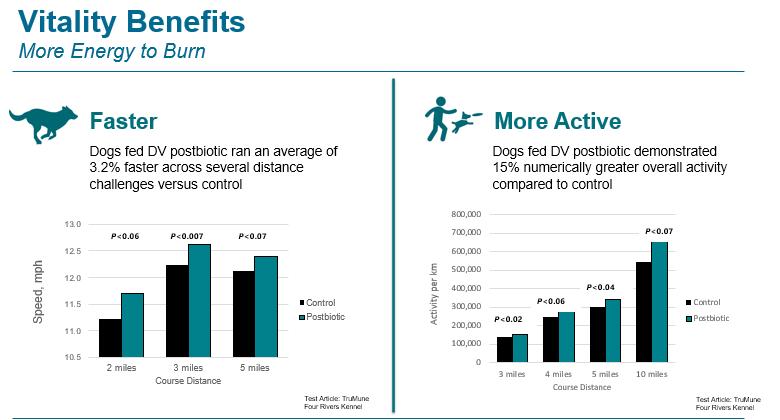
“Postbiotics should be considered a valuable part of pet nutrition,” adds Mrs Harvey-White. “Products like TruPet, which have been proven to support a strong gut and promote a healthier microbiome, can bring real benefits to the overall well-being of our pets.”
TruPet was launched in Europe in 2021. It is a consistent product used in products to promote a healthy digestive system via the gut microbiome and an effective immune system, leading to healthy, active pets. TruPet is cereal-free, GMO-free and scientifically proven, and it is stable through processing.
Other postbiotics from Diamond V for pets include Epicor Pets, for use in pet supplements and treats, and TruEquine for use in equine diets. “These all use the postbiotic technology developed by Diamond V to bring advantages to pet and equine wellbeing and performance,” adds Mrs Harvey-White.
Pet Food SuPPlement 2022 Page 33
Figure 1: Antioxidant support and immunity impact of Cargill’s TruPet postbiotic vs a control
Figure 2: TruPet vs Control diets – effect on digestive and gut health
Figure 3: Vitality benefits of feeding Diamond V postbiotic TruPet
The importance of nutrition for senior dog health
By Chloe Poolman, Pet Nutritionist, Premier Nutrition
Correct feeding of senior dogs is vital for healthy ageing, and in helping to control age related changes that might impact on the dogs’ quality of life.

as this may help to maintain lean body mass. Dietary supplementation of L-carnitine improves nitrogen retention, increasing lean mass and reducing fat mass (MacIntosh, 2001). Carnitine is biosynthesized in the liver and kidneys from the amino acids’ methionine and lysine in the presence of ascorbate. Although dogs can complete this pathway without additional supplementation, the level at which this synthesis can be maintained declines in older dogs.
Joint health
There is no defined chronological age as to when a dog progresses from being adult to senior, but pet parents tend to notice differences in their dogs’ health, activity level and weight as their pets age. The chronological age at which a dog enters its senior period will depend on breed and breed size and will also vary in individual pets. For example, a higher lifespan is expected in smaller breed dogs compared with larger breed and, in particular, giant breed dogs. Commonly, large breed dogs might be classified as senior from the age of 5-8 years old and small breeds from about 10 years of age (Michell, 1999).
Owners associate their pet’s well-being with behaviours learnt in their adult life, by their activity level on walks and their subsequent comfort whilst participating in these activities. Reduced mobility is one factor which is often noticed by pet owners as dogs age, but other common pathologies associated with age are renal diseases, obesity, dental issues, and cognitive impairments.
Weight and energy allowance
Senior dogs are at a greater risk of becoming overweight and obese so energy supply should be adjusted to maintain optimal body condition, especially where activity levels might become reduced as the pet ages. Maintaining an optimal body condition appears to be a key factor in healthy ageing in dogs and lifetime restrictive energy allowances increases median lifespan and delays the onset of chronic disease (Lawler et al., 2008) and osteoarthritis in dogs (Kealy et al., 1997, Lawler et al., 2008). Lower calorie density foods are one tool to aid owners to provide appropriate energy supply to senior dogs. However, it is important to provide sufficient high-quality protein to senior dogs

One area that is important to enable senior dogs to live a comfortable, active life is joint health. The first and second most abundant minerals in the dogs’ body are calcium and phosphorus, respectively. These are involved in both the structural formation of bones and teeth, as well as functional roles within blood coagulation and nerve impulse transmission (Stockman et al., 2021). Vitamin D is an essential nutrient involved in the homeostasis of calcium and phosphorus. If the requirements of these nutrients are not adequately met in early life, skeletal abnormalities may form which can severely impact the quality of life within the senior years and increase the inflammatory response caused by poor orthopaedic health. Adequate Ca:P ratios should be maintained in senior dogs.
Osteoarthritis is one of the most commonly diagnosed joint diseases in ageing dogs and is recognised as the progressive degeneration and remodelling of synovial joints as the cartilage becomes damaged and triggers an inflammatory response which can cause great discomfort.
Anderson et al., (2018) estimated 11.4% of dogs over 8 years old were affected by osteoarthritis. Although osteoarthritis has a known genetic influence, the disease can be exacerbated by the dog’s activity levels, diet and their breed, with larger breeds commonly experiencing
Page 34 Pet Food SuPPlement 2022
osteoarthritis at some stage. Glucosamine & chondroitin are ingredients commonly included in complete and complementary pet foods designed for joint health support for senior dogs. Glucosamine regulates the synthesis of collagen in cartilage, whereas chondroitin inhibits the destructive enzyme pathway which breaks down the cartilage and joint fluid (Bhathal et al., 2017). Alongside this, both ingredients contribute towards the creation of glycosaminoglycans and proteoglycans, which are recognised for being building blocks for cartilage formation (Beale, 2004). Also supporting the body’s natural anti-inflammatory response is the organic sulphur compound Methylsulphonylmethane (MSM) (Brien et al., 2008).
Supplementation of pet foods with omega-3 fatty acids for a period of 6 months significantly improved the ability of geriatric dogs to rise from a resting position, and improved comfort whilst walking (Roush, 2010). Omega-3 fatty acids have been shown to support the antiinflammatory response through increasing eicosanoids and reducing the activities of proteoglycan-degrading enzymes. Omega-3 fatty acids are commonly found in ingredients such as marine algae and fish oils. Furthermore, supplementing omega-3 fatty acids to senior dogs can also help support the immune system and positively modulate the gut microbiome when challenged (Fritsch et al., 2010).
Digestive health and fibre
Over time, senior dogs gut microbiota shows a gradual reduction in beneficial bacteria and an increase of facultative anaerobes which can generate an inflammatory response and increase oxidative stress (Pilla and Suchodolski, 2019). Changes in gastrointestinal function can result in inconsistent stool quality, longer colonic transit time and inefficient absorption of nutrients. The inclusion of fermentable fibre within the diet can significantly reduce the risk of enteric infection and improve nutrient absorption to overall improve quality of gut health and stools (Ephraim et al., 2020). Prebiotics such as fructooligosaccharides (FOS) and mannanoligosaccharides (MOS) promote the growth of the ‘good bacteria’, Lactobacillus and Bifidobacterium (Swanson et al., 2002). Diets for senior dogs should also contain sufficient fibre to ensure adequate intestinal motility, typically this is included in pet foods with ingredients such as sugar beet pulp.
Cognitive health
Senior dogs may experience age related cognitive decline as a result of oxidative damage caused by free radicals which can lead to dysfunction of neural cells (Head et al., 2007). Dietary antioxidants like vitamins E and C, and selenium may be important in helping to maintain antioxidative defence in older dogs. Cognitive dysfunction syndrome (CDS) results from irreversible degeneration of the brain beyond normal aging, including changes in brain glucose metabolism and is more severe than age related cognitive decline. Salvin et al., (2010) estimated that 14.2% of dogs 8 years and older are affected by CDS. Prevalence of CDS increases with age but remains underdiagnosed by veterinarians. Dietary supplementation with mediumchain TAG (MCT) has been shown to improve cognitive function in
aged dogs (Pan et al., 2010; Pan et al., 2017). There is consideration for the inclusion of omega-3 fatty acids to support cognitive health in ageing dogs.
Immune function
Senior dogs may develop age related immunocompetence (Hall et al., 2006). Zinc intake can be adjusted to higher levels within the recommended framework given its essentiality for many biological systems including immune function.
Prebiotics (FOS and MOS) have beneficial effects on the immune status of dogs by increasing IgA and lymphocyte concentrations (Swanson et al., 2002). High concentrations of dietary beta-carotene have been shown to heighten cell-mediated and humoral immune responses in dogs (Chew et al., 2000). Furthermore, carotenoids such as beta-carotene, lutein and zeaxanthin found in ingredients such as marigold meal are linked to maintaining healthy vision (Paiva and Russell, 1999).
As dogs age, their quality of life and daily activity is influenced by a range of conditions to differing extents depending on the size and breed of the dog. The healthy ageing of all senior dogs can be supported by the addition of functional ingredients, antioxidants, and correct nutritional management.

References available on request from:
Chloe Poolman - Pet Nutritionist
Email: chloe.poolman@premiernutrition.co.uk
Tel: 07892780264
Chloe Joined Premier Nutrition in 2019 as a Support Nutritionist after graduating Harper Adams University with a BSc (Hons) in Bioveterinary Science. Previous to this, Chloe completed a placement with a leading feed additive business.
Chloe Joined the Pet Team in 2021 to provide technical and nutritional support alongside legislation and labelling advice. Chloe is FAR registered and also a Registered Animal Medicine Advisor –category R.

Pet Food SuPPlement 2022 Page 35
Postbiotic Technology Invigorates Pet Nutrition Solutions for Microbiome and General Health
By James Kyffin, BVSc MRCVS, Commercial Director - Animal Health, ADM Protexin
Both the scientific community and the average consumer are fascinated by the gut microbiome and its implications for overall well-being, with new discoveries further fuelling interest. While much attention has been directed to the human microbiome, emerging research provides exciting insights relevant to companion animals. Furthermore, the expanding humanization of pets trend has many pet owners transposing their purchasing values and preferences onto their furry companions. So as more people take a proactive approach to their health and wellness with microbiome-supporting products, many are also closely monitoring their pets’ gut health and general wellness.
the viability and effectiveness of live microorganisms, which can limit the use of probiotics in processed pet foods and treats.
Postbiotics are a breakthrough in microbiome technology, as they are a preparation of inanimate microorganisms and/or their components that confer a health benefit on the host4. Postbiotics can withstand harsh processing conditions and are shelf stable, enabling their inclusion in a wide variety of applications, including pet food, treats and supplements.
Scientific Discovery Drives Product Innovations
Caenorhabditis elegans is a nematode that is being used as a cuttingedge in vivo research model to identify probiotic bacterial strains. The use of C. elegans offers many unique advantages, like its short, 21-day life span, ease of cultivation and a fully sequenced genome. ADM’s Biopolis laboratory has successfully demonstrated that C. elegans is particularly beneficial for the identification of potential probiotic and postbiotic strains that may be associated with various health benefits. Once a bacterial strain demonstrates its potential benefits in the C. elegans model, the probiotic or postbiotic is selected for additional research trials in murine models, humans, dogs and cats.
Products with functional ingredients that support the microbiome are increasingly in demand, as they may help address key areas like immune function, digestion, metabolic health and skin and coat characteristics. Notably, 60% of pet owners say they would like the pet foods and treats they purchase to have a digestive health benefit1

The Power of Postbiotics
Probiotics are recognized as live microorganisms which, when administered in adequate amounts, confer a benefit on the host2 According to research, 58% of global consumers perceive a connection between the function of the bacteria in the gut to wider aspects of well-being3. However, certain processing conditions may compromise
One strain to undergo rigorous testing is ADM’s proprietary probiotic, BPL1™* ( Bifidobacterium animalis subsp. lactis CECT 8145) and its heat-treated counterpart, BPL1™ HT. In multiple animal models and a human clinical trial, the probiotic and postbiotic forms of BPL1™ have been shown to favourably affect markers associated with metabolic health5-10. Another example is ADM’s ES1** (Bifidobacterium longum subsp. longum CECT7347). In preclinical models, ES1** has shown potential to modulate immune responses in animal models and have positive effects on the gut barrier integrity11,12. It also may affect skin and coat characteristics13. Both BPL1™ HT and ES1** HT are materials that can be used in feeds in the European Union and United Kingdom.
The Future in Focus
There remains much to learn about the potential of biotics to support the microbiome, in humans and other animals. For example,
Page 36 Pet Food SuPPlement 2022
researchers are just beginning to understand the implications of the microbiome-gut-brain axis. Scientific evidence points towards an important link between the brain and the microorganisms found in the gut, with an increasing range of health aspects thought to be linked to this bi-directional communication system, including cognition and mental well-being. In an aquatic model of anxiety, zebrafish treated with ES1** and Lactobacillus rhamnosus CECT8361 demonstrated significantly altered swimming patterns and mean swimming speed, and strongly reduced their bottom-dwelling behaviour12. In this model, these behaviours are thought to correlate with a lower state of anxiety, leading the research team to conclude that this particular combination of strains could have interesting applications12
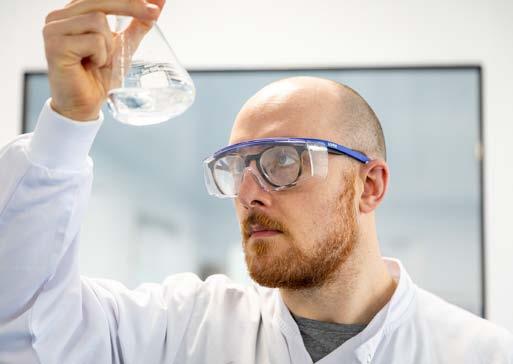
Consumers typically make incremental changes to their pets’ diet by introducing supplements or treats with functional ingredients. Visual cues can indicate the inner health of a pet, from a shiny coat to clean teeth to log-shaped stool. Microbiome support through biotics and synbiotics – combinations of prebiotics, probiotics and/or postbiotics – can go a long way to maintaining a pet’s quality of life.
Veterinarians, pet nutritionists and other industry thought leaders are key to expanding consumer awareness and understanding of functional and balanced diets. As demand grows for premium pet nutrition products with added functional ingredients, pet brands can gain consumers’ trust with a partner that delivers technical capabilities and science-backed solutions for healthier, happier pets.
*BPL1®(word and logo) is a trademark registered for Biopolis S.L. in the EU, and other countries.
**ES1 (Bifidobacterium longum subsp. longum CECT7347) is used by ADM Biopolis under license from CSIC
References
1Mintel, Pet Food’s Take on Gut Health, June 2021
2FAO/WHO, 2002
3ADM Outside Voice℠
4ISAPP, 2021
5Wernimont; et al. (2020) Frontiers in Microbiology, 11(1266).
6Chenoll; et al. (2014) Genome Announcements, 2(2), e00183-14.
A deeper understanding of the microbiome-gut-brain axis is especially relevant as heightened stress from global uncertainties continues to plague people and their pets. According to ADM research, 41% of dog owners are concerned about separation anxiety as they spend more time at the office or travelling3. Half (50%) said that being away from home may exacerbate behavioural issues3
Functional Nutrition Solutions for Microbiome Support
As more consumers accept pets as a part of the family, there is growing demand for premium pet nutrition products. Beyond the complete and balanced diet required of a dog or cat at various life stages, many pet food offerings now feature added functional ingredients to target specific concerns. For instance, fish oil and fish meals rich in omega-3 fatty acids support brain development in growing puppies. Natural antioxidants are linked to immune function support, and prebiotics, probiotics and postbiotics promote gastrointestinal health for pets of all ages. Biotics can help balance the intestinal microbiota, increase nutrient absorption, and may positively impact digestive, immune and metabolic health.
Maintaining a pet’s ideal body weight and body condition is critical, as overweight pets may have a reduced quality of life. Besides portion control and regular exercise, pet owners can support general wellness with novel dietary ingredients.
7Martorell; et al. (2016) Journal of Agricultural and Food Chemistry, 64(17), 3462-3472.
8Caimari; et al. (2017) Journal of Functional Foods, 38, 251-263.
9Carreras; et al. (2018) Beneficial Microbes, 9(4), 629-641.
10Pedret; et al. (2019) International Journal of Obesity, 43(9), 18631868.
9Laparra; et al. (2012) PloS one, 7.
11Martorell; et al. (2021) Antioxidants, 10, 536.
12Valcarce; et al. (2020) Heliyon, 6(5), e03973.
13Navarro-López; et al. (2018) JAMA Dermatology, 154(1), 37-43.
James Kyffin is the commercial director for animal health at ADM’s Protexin business and the business development director for the Pet and Animal Well-being division of ADM Health & Wellness. He is a qualified veterinary surgeon, having qualified from the University of Bristol in 2005. After five years working in small animal clinical practice in the UK, he joined ADM Protexin and has filled a variety of roles within the business over the last 12 years.

Pet Food SuPPlement 2022 Page 37
Global survey shows consumers want recognisable and health-promoting ingredients in pet food

A recent global study, conducted by market research company Wizer on behalf of BENEO, has found that the primary interest of dog and cat owners is for natural pet foods with additional health benefits. With the majority of pet owners expecting their pet’s food to be the same quality as their own, there is significant demand for high quality, natural and healthy ingredients. The survey included 2,500 dog and cat owners in the UK, USA, Brazil, Germany and China1.
The research highlights how pet food trends continue to mirror those in human nutrition. It demonstrates the vast market potential for the use of clean label, health-promoting and no- or low-allergenic ingredients, with sustainability and plant-based origin also now of increasing importance.
health improves the likelihood of them purchasing a product, inducing them to actively look for easy-to-digest products. Notably the demand for prebiotics is gathering pace and their benefits are widely perceived, with 70% of respondents agreeing that adding such fibres to pet food makes it seem healthier. A recent Mintel study further confirms this interest in prebiotic ingredients for pets, with half of the product launches of dry cat and dog food in Europe now containing inulin, fructo-oligosaccharides or chicory derived products2
Increasing sustainable focus
Another consumer trend that is further shifting into the realm of pet foods is that of sustainability, with more than half of owners now stating that they pay attention to sustainability and the carbon footprint in purchase decisions of their pets’ food. According to the survey, using claims such as “environmentally friendly” improves consumer interest in buying a pet food product.
BENEO offers a range of chicory root fibres and rice ingredients that help manufacturers address the increased demand for clean label and healthy pet foods. Besides their nutritional benefits, BENEO’s range of rice ingredients have outstanding technological properties, making them suitable as natural alternatives to modified starches and hydrocolloids or enhancers of physical characteristics in many types of pet foods and snacks. The company has also built its business around the sustainable sourcing of all its plant-based ingredients.
Naturalness and clean label drives pet food purchasing
According to the survey, consumers are increasingly considering natural aspects when buying food for their pets. Using less or no additives makes pet food appear healthier for more than 4 in 5 pet owners. BENEO’s findings also demonstrate that pet foods featuring natural ingredient claims have a significant influence on their purchase prospects, with 79% of pet owners checking the label for any ingredients they dislike. Many potential customers are also calling on brands to make it easier to track what’s contained within pet foods, making this an important area of focus for producers.
Alongside the demand to eliminate additives from pet foods, a spotlight is also being placed on allergenic ingredients: three quarters of pet owners agree that using no allergens, such as soy or corn, makes food for pets seem healthier1. BENEO’s rice ingredients are a viable way to reduce the allergenic components in pet foods and enhance their appeal to consumers.
Support of healthy digestion a priority
As in human nutrition, healthy digestion is also driving buying behaviours in pet foods. More than 90% of pet owners say that supporting digestive
Maygane Ronsmans, Product Manager Animal Nutrition at BENEO, comments: “The findings of this latest pet survey highlight the rising demand from owners for understandable, cleaner ingredients labels and for healthier nutrition for their pets. We are also seeing this reflected through the rising number of customers favouring BENEO’s clean label and hypoallergenic rice starches and proteins, which are the ideal plantbased solutions for premium pet foods.
“The technical properties of our functional rice ingredients allow producers to use them as natural ingredients, and their nutritional benefits make them suitable for sensitive pets, or those with allergies. The combination of BENEO’s natural and plant-based ingredients and its expertise in healthy nutrition help manufacturers bring to market new and relevant pet food products that meet these consumer demands.”
References
1 BENEO Consumer Research on Attitudes towards Pet Food (Online survey) conducted in local language by Wizer for USA n=510 / Brazil n=515 / UK n=505 / Germany n=514 / China n=512
Field work conducted in July 2021
2 Mintel GNPD, Share of New Product Launches in Europe for the year 2021 (extraction date: Jan 2022)
Page 38 Pet Food SuPPlement 2022
PFMA W ELCOMES C LAIRE R OBINSON -DAv IES O F NESTLé PURINA AS THE ASSOCIATION’S NEW CHAIR


At its recent AGM at the end of March, the Pet Food Manufacturers’ Association (PFMA) welcomed new Chair, Claire Robinson-Davies , Nestlé Purina Corporate Communications Director (UK&I, Netherlands, Nordics).
Claire brings a wealth of experience to the role following many years as a representative on the PFMA Executive Committee and Chair of the Sustainability Committee. Sustainability will be a focal point for Claire’s two-year tenure: “As a responsible industry, environmental sustainability continues be high on the PFMA’s agenda. We also know pet owners want to feed their pets in a way that respects and protects the environment for future generations. We are working closely with government and other organisations to ensure we address common challenges, including sustainable raw materials, environmentally friendly production, and recyclable packaging materials.
Supporting our members in their decarbonisation journeys is particularly critical, which is why we recently embarked on an exciting project looking at the sustainability of key pet food ingredients. We look forward to sharing the results later this summer. I am excited and honoured to take up this role and to help shape the way forward for our industry.”
Michael Bellingham, PFMA Chief Executive, adds: “Claire joins
a strong Chair team with Greg Van Praagh (Benyfit Natural) as Past Chair and Anna Horrell (Goldline Feeds) as Vice Chair. Work is already underway for an action packed two years ahead.”
TROUW APPOINTS NEW PET TECHNICAL MANAGER
Sarah-Jane Godfrey has been appointed to the role of Pet Technical Manager. A graduate in Agriculture from The University of Nottingham, specialising in animal science, she brings 20 years’ experience of animal nutrition and the pet sector.

She initially worked as a pig and poultry nutritionist with a national feed compounder before moving to DSM, building 14 years’ experience in the premix business working up to the role of Pet Food Technical Marketing Manager for the EMEA region. She also held responsibilities for the UFAS scheme and HACCP.
“Working across the UK and in Europe, my role is to facilitate the formulation of our pet food customers premixes and provide them with nutritional advise and support. I am also there to support our customers NPD pipelines to provide market relevant nutritional solutions, so their pet foods and treats are on point, and provide the nutrition that pet owners demand.”

“I hope my experience in the feed and pet sectors across technical, commercial and quality focused roles will allow me to provide complete and robust support to pet food customers.”

Pet Food SuPPlement 2022 Page 39 … PET SUBJECTS … PET SUBJECTS… PET SUBJECTS … PET SUBJECTS …
PREMIER NUTRITION STRENGTHENS PET TEAM WITH NEW APPOINTMENT
Following a period of business acceleration, Chloe Poolman has become the latest recruit to join the pet team at Premier Nutrition, the specialist nutrition consultancy and premix division of AB Agri.

Miss Poolman initially joined Premier Nutrition’s technical team as a support nutritionist, working across all the species, following the completion of a degree in Bioveterinary Science at Harper Adams University.
“As part of my new role I will be providing tailored support and advice to our customers in the pet food industry. I will be analysing the latest research and looking into developing premix formulations for a variety of diet formats, including treats, while working closely with our customers,” she says.
Joining the business just before the Covid-19 pandemic restricted Miss Poolman from getting out and meeting people from the pet food sector, but she is hoping to create new relationships through networking events and conferences this year.
“Despite the restrictions that have been in place, I’ve been very fortunate in working alongside a great team with a fount of knowledge in pet nutrition. Tapping into the team’s expertise and through my own industry research, I’ve been able to further develop my technical knowledge and will be putting this into practice by producing and publishing technical reviews for our customers.”
R ESPONSE TO R ECENT S TUDY O N P LANT-B ASED vERSUS MEAT-BASED DIETS FOR DOGS
A recent study on the benefits a vegan diet can have for pets, published in the Guardian, has sparked widespread debate on whether this is the perfect diet for your dog or not.
Responding to the study, Bella & Duke’s Chief Consulting Nutritionist, Rowan Sanderson, said: “Even within this study, the dogs that were fed raw meat diets were healthier than the vegan dogs overall.
We all want the best health for our pets, the facts show there is nothing better for your pet than a high quality species-specific raw diet, which offers the healthiest and most natural option for your pet. There are only benefits to starting your pet on a raw diet – from maintaining a healthy weight, aiding digestion, supporting healthy bones and joints, to keeping coats soft and shiny and moreover there are no long terms studies on the health impacts of a vegan diet on pets.
Dogs are facultative carnivores. This means that their primary source of nutrition should stem from animal protein, but that they can, and do, eat some plant material. These plant fibres help to develop a robust flora of protective bacteria which is one of the most important parts of their immune defences. However, a long term vegan diet poses a spectrum of health problems as it is devoid of those all-essential amino acids that are found so readily in raw meat.
There is also a strong correlation between inflammation in the heart
and diets which are high in lectins and laden with omega 6 fats. This includes pea proteins and legumes, which are so often the source of the alternative protein within vegan diets for pets.”
The Pet Food Manufacturers Association also commented on the controversial study stating on their website that: “We encourage research into pet diets as this contributes to the overall knowledge and better understanding of pet nutrition and health. Plant-based diets are still relatively new, the numbers of pets fed this way is relatively low and the historic information is limited. As a result, there is currently insufficient evidence to suggest that a vegan dog food diet is healthier than a meat-based diet.
The author of this most recent study acknowledges its limitations, for instance the health statistics cited are based on pet owner perceptions rather than clinical reports or facts, and with regards to sample size, the conventional diet was 4 times as large as the vegan diet”.
To help provide a broader perspective than has been shared in media articles, they have encouraged owners to read the PFMA Factsheet on Vegan and Vegetarian Diets which is available on their website.
BENEO INvESTS €50 MILLION IN PULSE-PROCESSING PLANT
BENEO, has announced a €50 million investment in a new pulse processing site in Offstein, Germany. The site will produce protein rich pulse ingredients for food and animal feed. It will focus initially on protein concentrate, starch rich flour and hulls from Faba bean, with the option to process other pulses in the future. The new production site further strengthens the company’s plant-based protein portfolio and enables BENEO to meet growing demand for plant-based food and feed ingredients.
Throughout BENEO’s entire supply chain sustainability is top of mind. Pulses help to reduce green house gas emissions at farm level and the Faba beans will be locally sourced from farmers that are certified by the Sustainable Agriculture Initiative (SAI). As BENEO is manufacturing Faba bean protein, starch rich flour and hulls, the crop will be fully used and completely valorised for functional ingredients. Furthermore, the production process has been chosen for its low energy consumption in comparison to alternative processes; overall contributing to BENEO’s carbon neutrality and sustainability targets.
Work has already begun on constructing the plant and is expected to be completed within the second half of 2024, creating up to 25 jobs at the Offstein site. However, to ensure that food and feed customers can benefit as soon as possible from Faba bean ingredients, BENEO will process the raw ingredients in intermediate production facilities, until the new plant is fully operational. This means that first quantities of BENEO’s Faba bean ingredients will be available from the start of June 2022 onwards.
BENEO’s Faba bean protein concentrate and starch rich flour will be used for protein-enrichment and texture improvement in meat and dairy alternatives, as well as (gluten-free) bakery and cereals. Faba bean hulls and starch rich flour will be used in feed as a vegetal protein or fibre source for sustainable petfood, aquafeed and livestock nutrition.
Page 40 Pet Food SuPPlement 2022 … PET SUBJECTS … PET SUBJECTS… PET SUBJECTS … PET SUBJECTS …

biochem.net E.C.O.Trace® E.C.O.Trace® Contact us: · +44 7722 019727 Organically Bound Trace Minerals. Small Input - Great Effect.
Fylax® Petfood - Effective mould control and moisture optimisation to extend shelf-life
Through our feed processing and quality programme, we offer pet food producers total solutions to maintain kibble quality, optimise moisture content and prevent mould growth, to ensure and extend shelf-life.

THE BENEFITS
Technical support
Laboratory service
Effective dosing and application
To learn more visit trouwnutrition.co.uk/globalleader
FEED PROCESSING AND QUALITY



































































































 By Dr Jason Sands; Head of Nutrition, Ocean Harvest Technology
By Dr Jason Sands; Head of Nutrition, Ocean Harvest Technology






 With Alana Harvey-White, Commercial Manager Pet and Equine, Cargill
With Alana Harvey-White, Commercial Manager Pet and Equine, Cargill
































